Just landing in Egypt had us giddy with anticipation. It was a destination that we always thought we ‘probably should visit’ … now that we were here, we couldn’t wait to see the storied antiquities we had read so much about.
Egypt is known as “The Cradle of Civilization” and has one of the longest histories of any country. Human remains have been found from around 18,000 BC. Egypt’s cultural heritage can be traced back to the 6th–4th millennia BC. Love this graphic on the various world civilizations.
So… Egypt’s really old 🙂 But most ‘important’ things started to happen in Ancient Egypt around 3,000 BC when 2 things occurred: 1) Upper (south) and Lower (north) Egypt were unified, and 2) the language – only spoken until then – began to be written. (The Nile River flows from the higher elevations of south of Egypt to empty into the Mediterranean Sea in the north of Egypt, which is why southern Egypt was known as Upper Egypt.)
For example, this appears to have been a critical time for the development of technology, especially metal making: the Egyptians as well as the Mesopotamians independently discovered that by mixing a small quantity of tin ore with copper ores they could make bronze which is harder and more durable. This set off a chain of connected innovations that could not have happened without the primary discovery.
Other Ancient Egyptian inventions that we still use today include paper, pens, toothpaste, even locks and keys.
The Gift of the Nile
Egypt is largely (about 92%) covered by a desert – most areas receive only 3 inches of rain per year – making the Nile River crucial to life in Egypt. 95% of the Egyptian population lives within a few miles of the Nile.
Rivers have been crucial to most (all?) great civilizations, bringing fertile sediment for growth, food and life to their floodplains, and this was certainly true of ancient Egyptians and the Nile. Egypt’s vast deserts protected the region from invaders while the river sustained those who lived along it while also providing a means of transportation. It was so crucial to life that the ancient Egyptians invented the 365-days a year calendar based on the heliacal rising of Sirius, which was the start of the annual flooding of the Nile River (click the link for an interesting quick read about the first calendars).
The Nile has been in U.S. newspapers just this week:
“The dam filling Egypt with dread. This summer water from the Nile River’s main tributary will start spilling into a reservoir about the size of London, thanks to a new $4.5 billion hydroelectric dam in Ethiopia. While Ethiopians cherish the project as a sign of progress, Egyptians downriver are considerably less excited, as Declan Walsh and Somini Sengupta write in the New York Times. As one worried farmer put it, “Egypt wouldn’t exist without the Nile.””
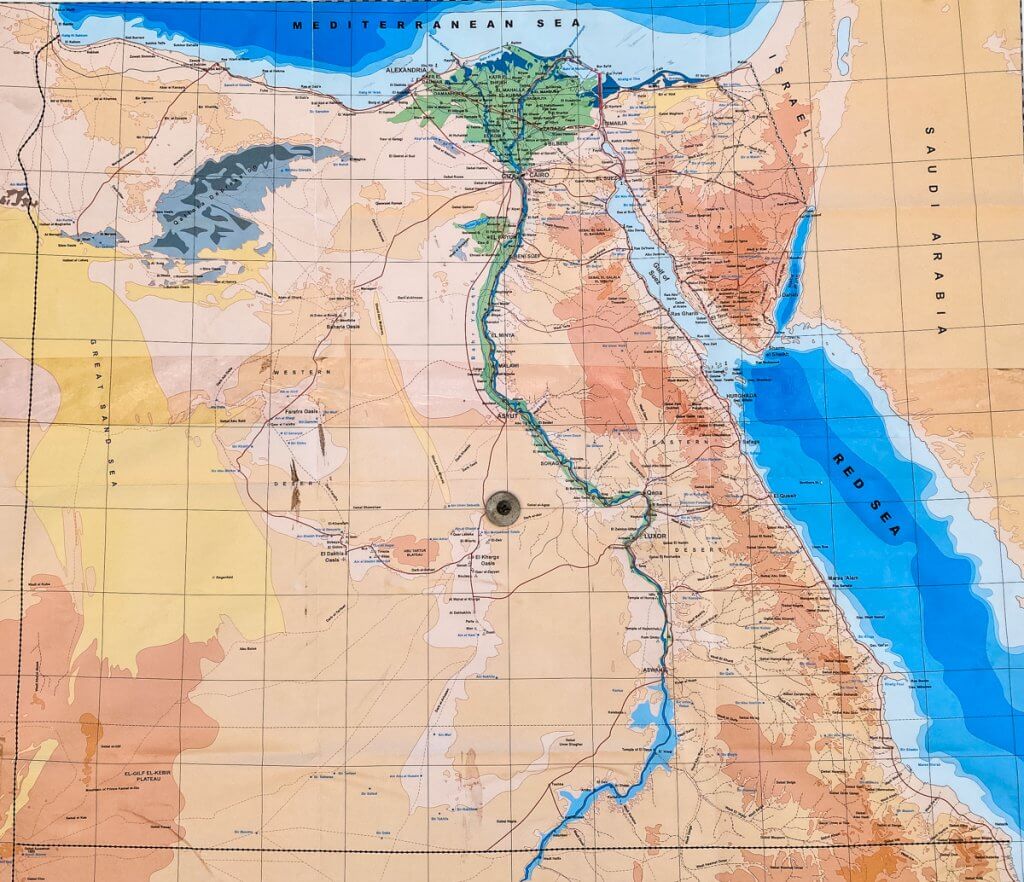
This map of the Nile shows the its course through Egypt. Considered the longest river in the world at approximately 4,200 miles, it is the lifeblood of Egypt which is over 90% desert.
Quick Facts about Egypt Today
- Egypt is a country of about 100 million, with over 80% Muslim and the rest mostly Christian.
- Egypt is about 1/10 the size of the U.S.
- The country is ethnically homogeneous, with Egyptians comprising more than 99% of the population.
- Cairo has served as Egypt’s capital for more than 1,000 years, but the government is building a new capital some 45 kilometers (28 miles) to the east to help ease congestion in Cairo. Plans call for the yet-to-be-named city to host the main government departments and ministries, as well as foreign embassies.
- One of the most famous figures tied to Egypt, Cleopatra VII, was Greek.
We’re not ignoring the Egypt Revolution in 2011 and the state of the country today …. more on that in our final post on Egypt.
Our Travels Through Egypt
Although Egypt is known for its 130+ pyramids and other treasures of antiquity, they owe their existence to the Nile. With the help of Khashana Adventure Travel, we chose an itinerary that ensured we covered both on this trip. The first half of our Egyptian adventure was a 4-night boat ride up the Nile aboard the Sanctuary Sun Boat IV. The second half was spent in Giza and Cairo exploring the pyramids and learning more about Egyptian culture and history.
Our Arrival in Luxor
We arrived in Egypt the evening before our cruise departed and stayed at the Hilton Luxor Resort, just a few minutes away from the Temple of Karnak. Our hotel room overlooked the Nile and gave us our first glance of the river that we would soon be cruising up (to the South :).
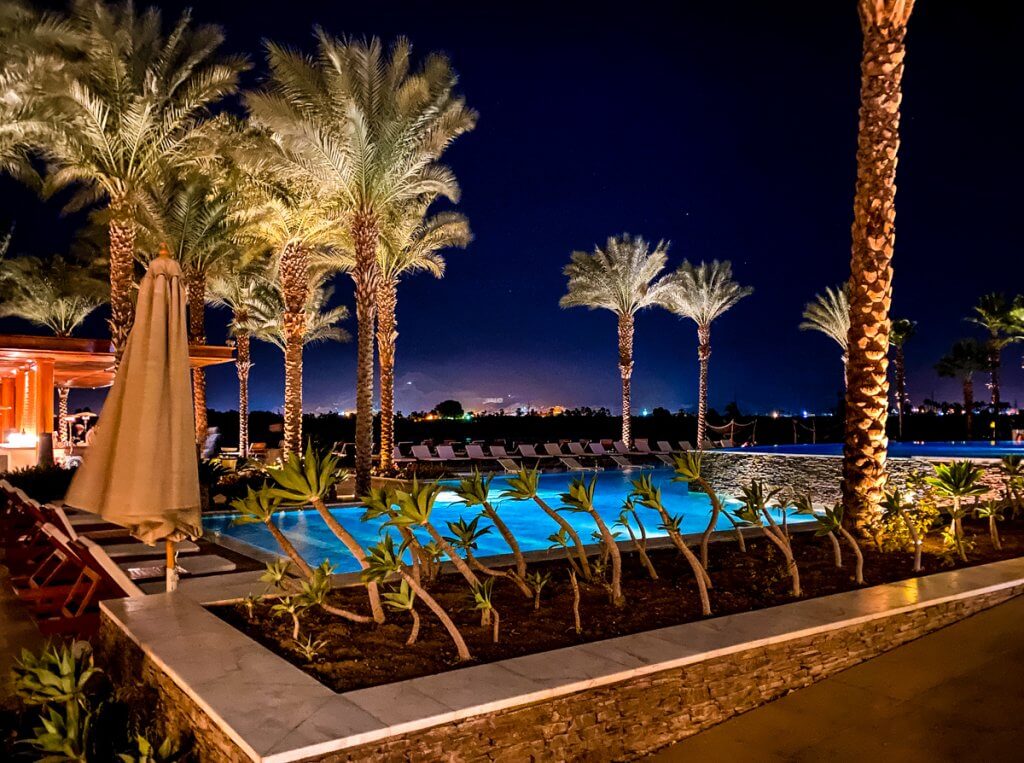
Our first night in Egypt was at the Luxor Hilton, overlooking the Nile. 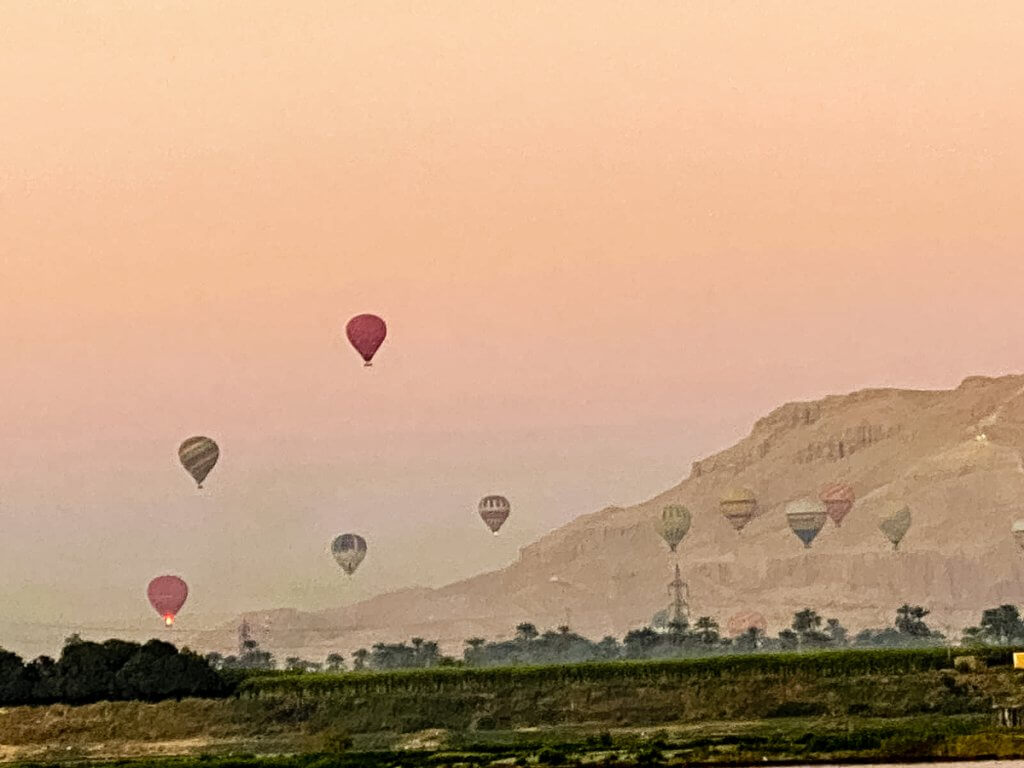
Our first morning in Egypt, looking across the Nile from the Luxor Hilton. 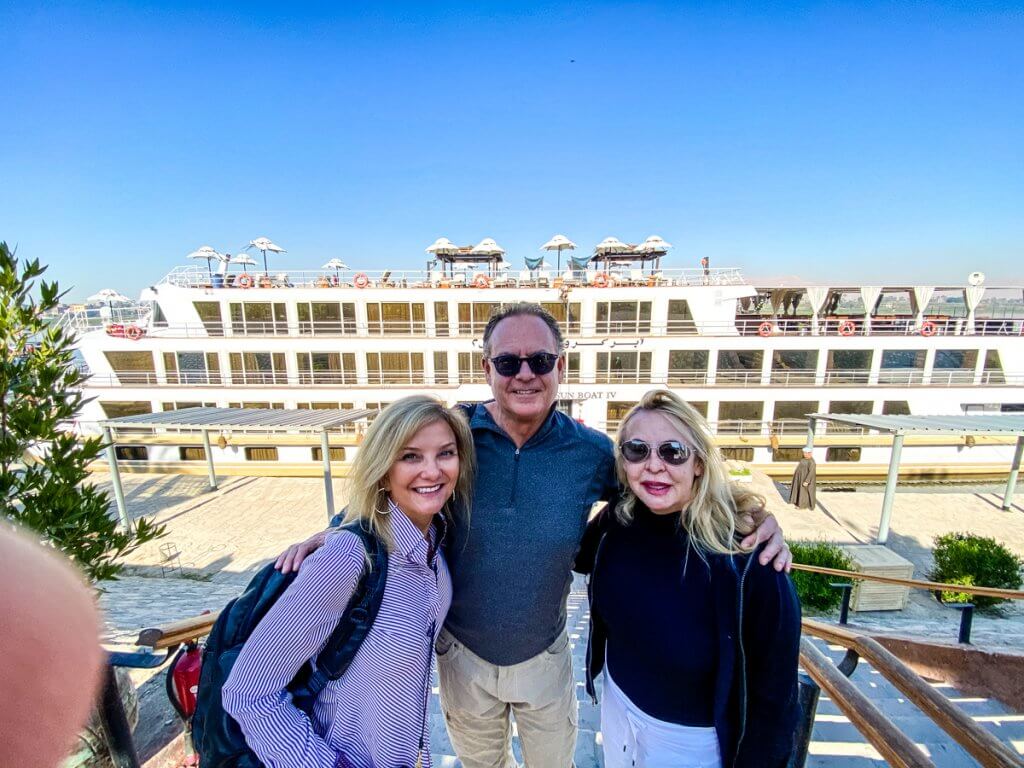
About to board the Sanctuary Sun Boat IV for a 4-day cruise from Luxor to Aswan.
Cruising the Nile from Luxor to Aswan

Our floating home on the river was the 236-foot Sanctuary Sun Boat IV. Though it was ‘low season’, we saw at least 100 cruise boats on the Nile (there are 475 in total), and we were very happy we chose Sanctuary. The generous upper deck especially with its shady comfortable lounge areas created the perfect perch from which to watch the banks of the Nile pass by.

Day #1 – Embarking in Luxor
Aboard the ship, we met our Egyptologist for the cruise, Ossama, who would paint a picture – and weave a story – for us during the coming days of Ancient Egyptian mythology, religion and daily life, as well as giving us insights into Egypt today. Day 1 would include visits to both the East Bank and the West Bank.
One of the cornerstones of Egyptian mythology is the most revered god, known by many names, but we’ll use Amun-Ra. In the early days of Egyptian civilization, he was worshipped as two separate gods. Amun was the god who created the universe. Ra was the god of the sun and light, who traveled across the sky every day in a burning boat. The ancient Egyptians thought the earth was flat. Every night, the sun got buried underground in the west at sunset, and journeyed through the underground during the night to be resurrected in the east every sunrise. Thus the temples on the East Bank of the river were for life, daily rituals. Burials, tombs and temples for honoring and worshipping the dead were on the West Bank.
Luxor Temple was the first temple we visited, on the East Bank. Right from the start, we were in awe.

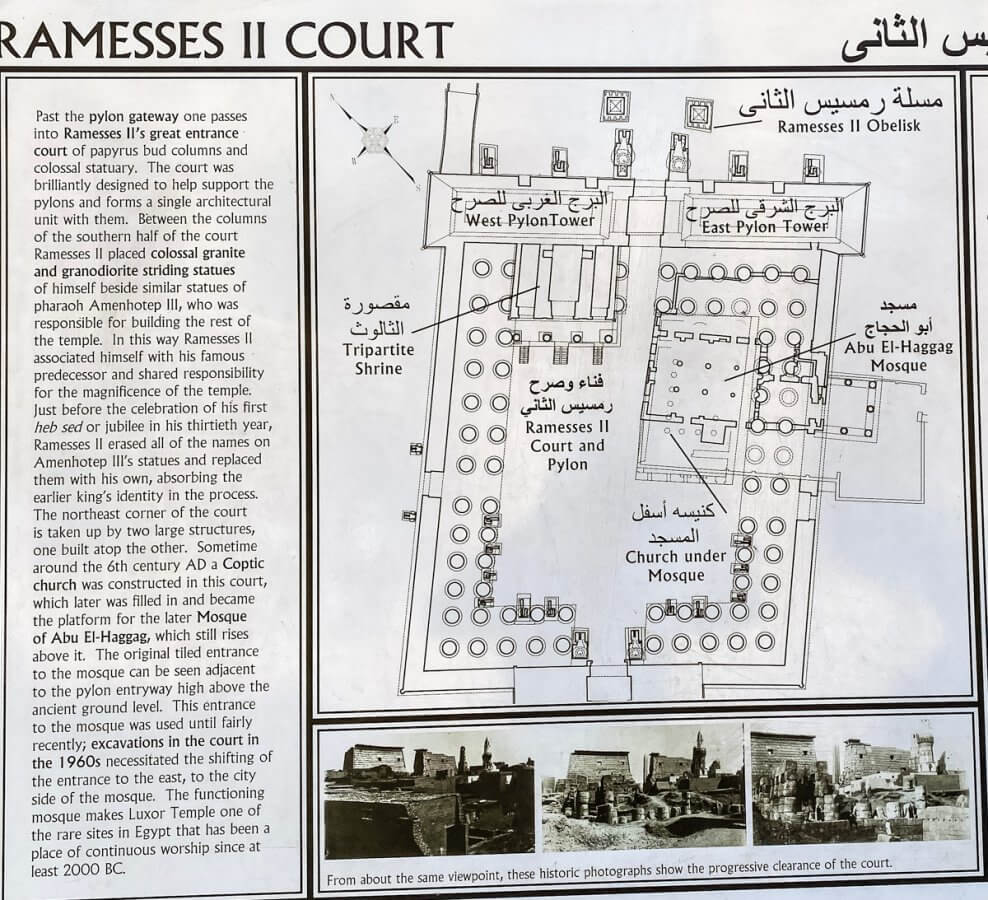
A diagram of the Luxor Temple. The entrance (where the remaining obelisk resides) is at the top center of the diagram. 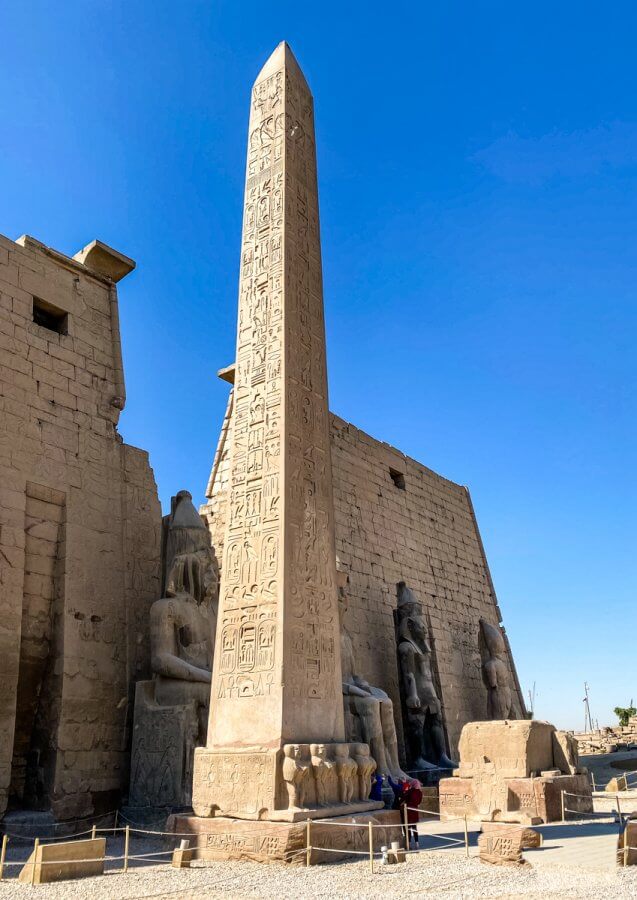
Ramses II Obelisk, which is a twin to the obelisk at the Place de la Concorde in Paris. The empty pedestal is visible in the bottom right of this picture. The obelisk was “given” to France by the ruler of Ottoman Egypt in 1832 in exchange for a mechanical clock (which didn’t work by the time it arrived in Egypt). 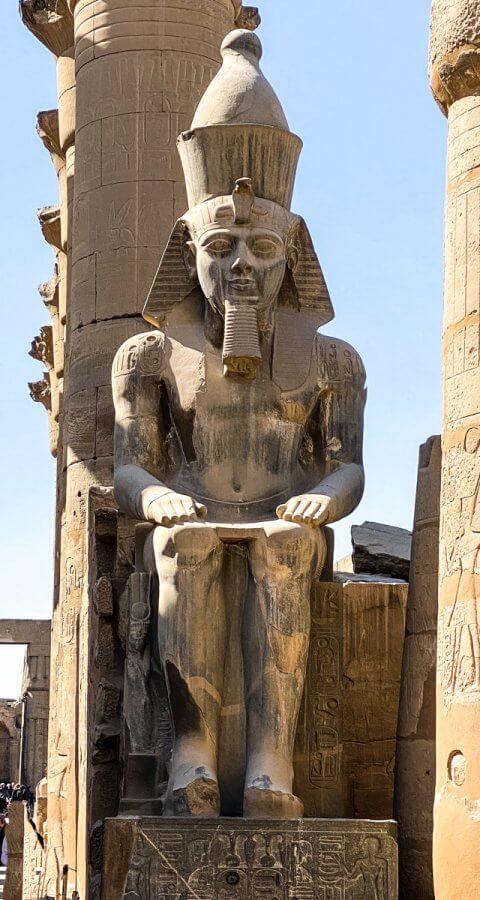
A fantastically well preserved statue of Ramses II who was born in 1304 BC, ruled for 65 years and died at the age of 90. 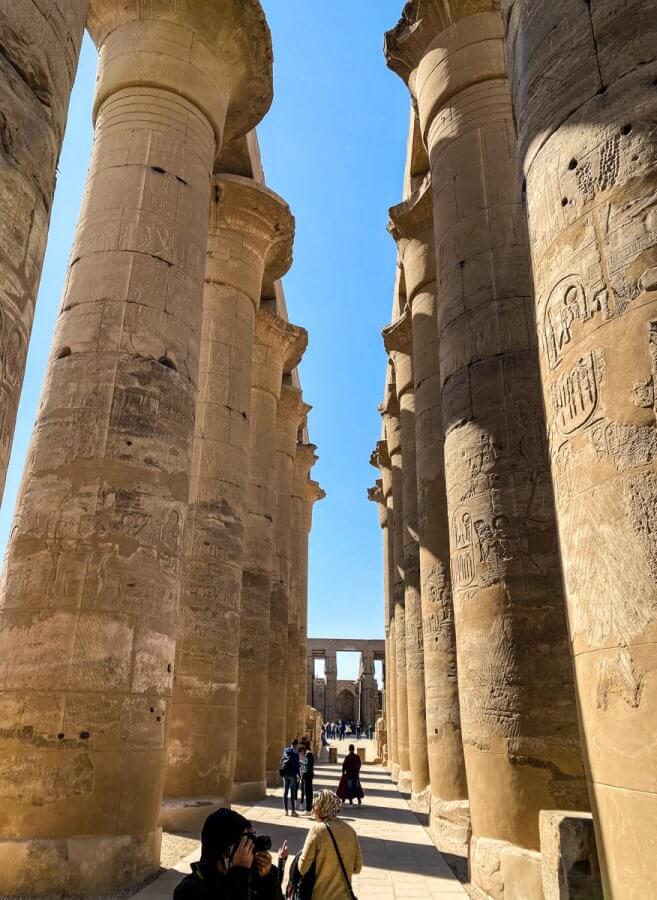
Towering columns supported the roof structure. 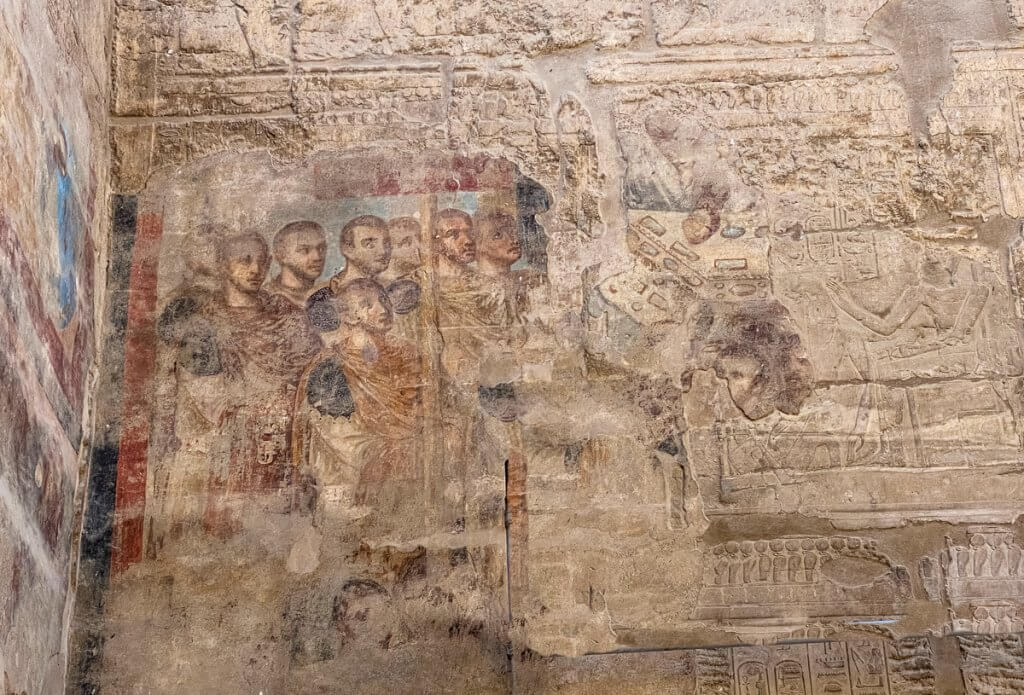
Roman murals painted in 1st century AD…..on walls that were built in 14th century BC. 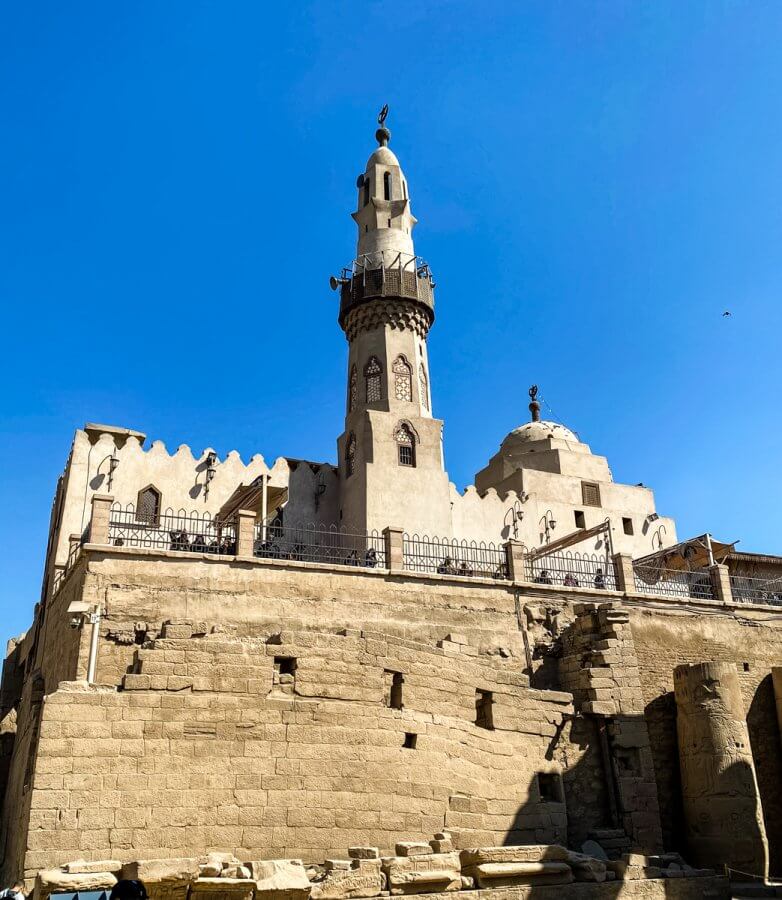
A mosque built sometime after 800 AD on top of a temple built in the 14th century BC. At the time it was built, the mosque was close to ground level as the temple had been buried by sediment. 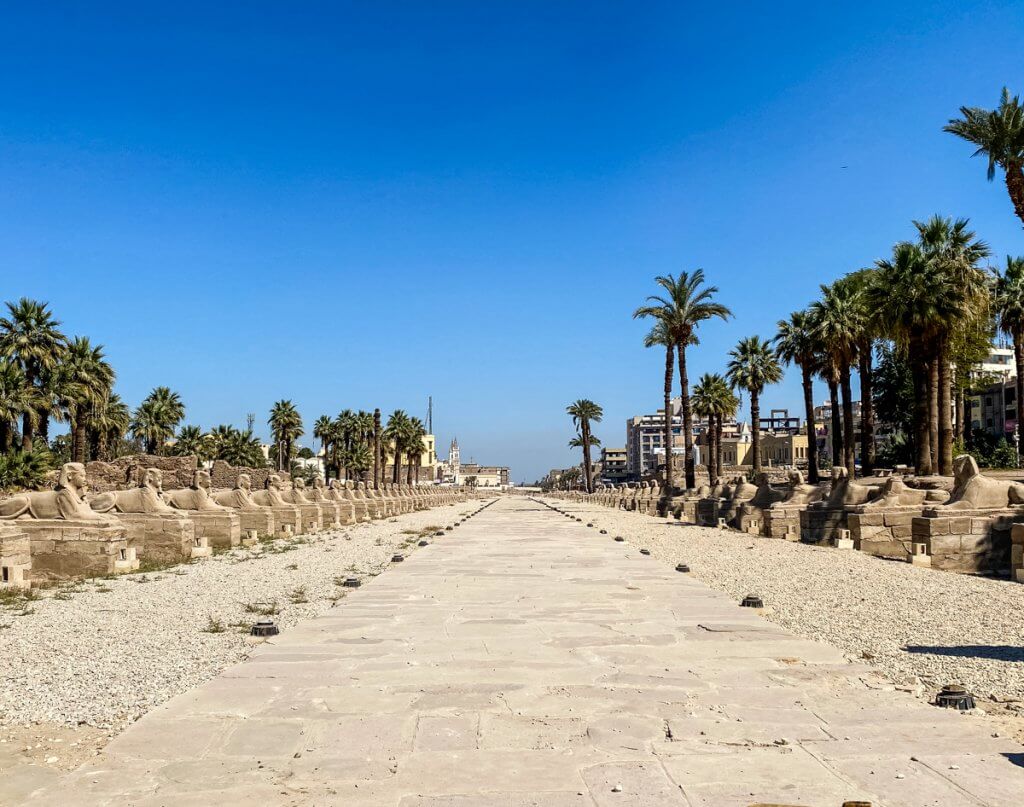
The Avenue of the Sphinxes traversed about 2 miles between the Luxor Temple and the Karnak Temple. 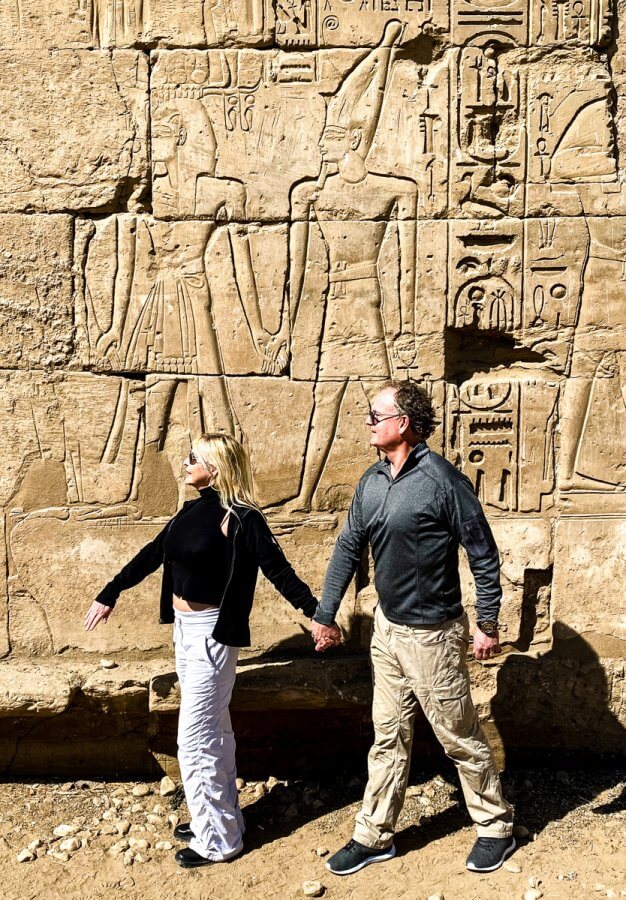
Walk like an Egyptian….
During the afternoon we crossed by ‘taxi’ (boat) to the West Bank of Luxor to explore the Valley of the Queens and the Valley of the Kings where we visited several tombs. These valleys contain the burial grounds of many of the Egyptian pharaohs. This is where the tomb of Tutankhamun was discovered, by Harold Clark in 1922. The tomb walls were lined with beautifully preserved colorful hieroglyphs depicting stories of ancient times and the life of the person buried therein.
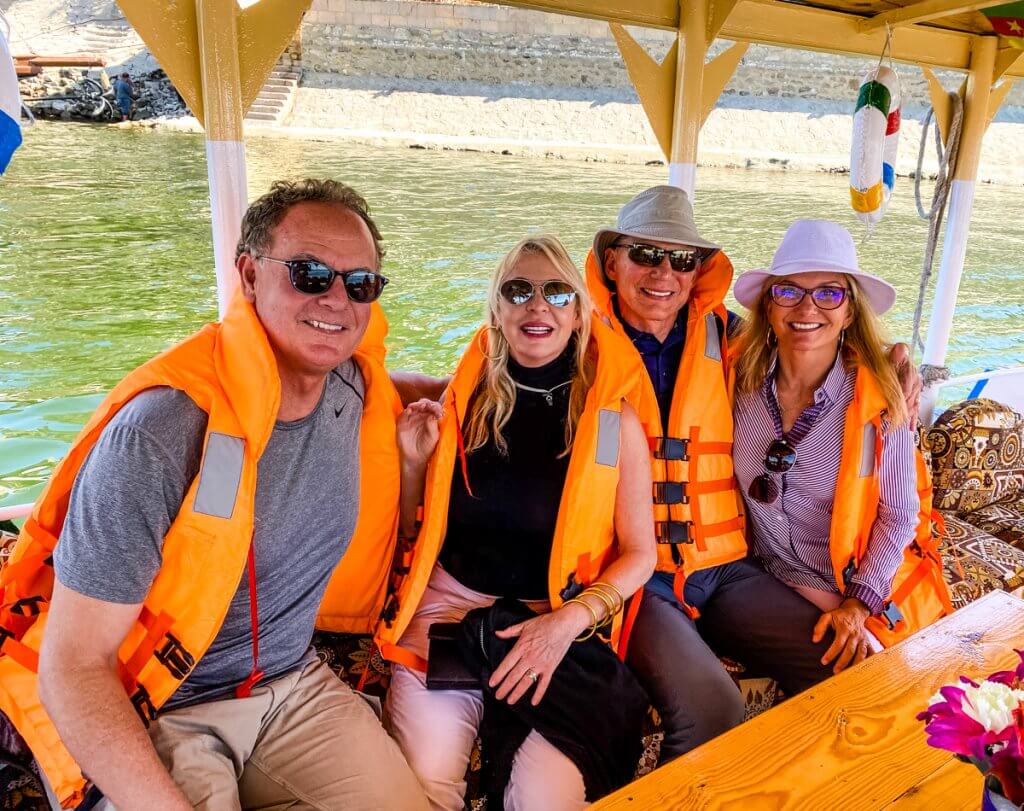
Still in Luxor, we shed our traditional Egyptian dress for our boat ride across the Nile….heading to the Valley of the Queens and the Valley of the Kings. 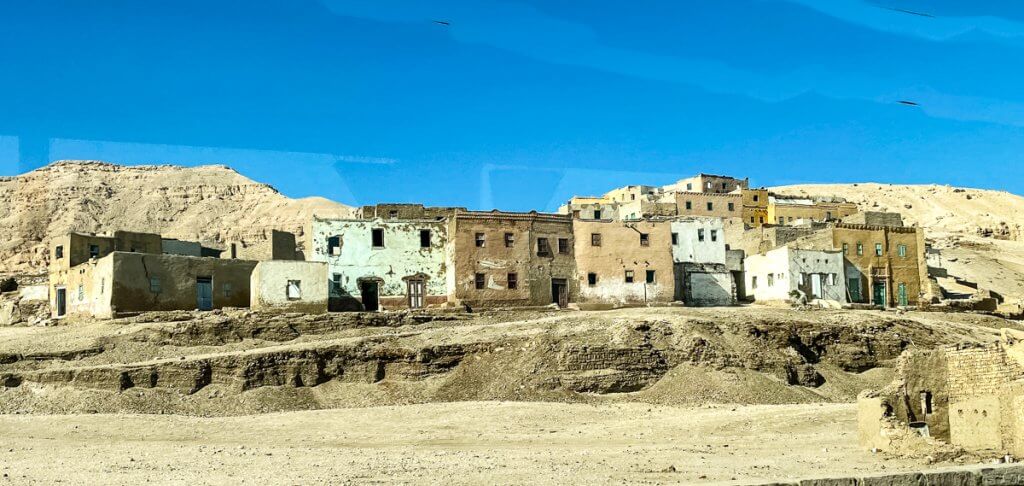
New Qurna was built in the 1940s to house the then residents of Qurna, who strongly resisted the move. The then inhabitants of Qurna lived in poverty, and built their homes over the entrances to ancient tombs in order to surreptitiously rob them of their treasures as a means of subsistence. In order to stop the looting the Department of Antiquities expropriated the land on which the Qurnis lived and moved them to the new settlement (now abandoned).[7]
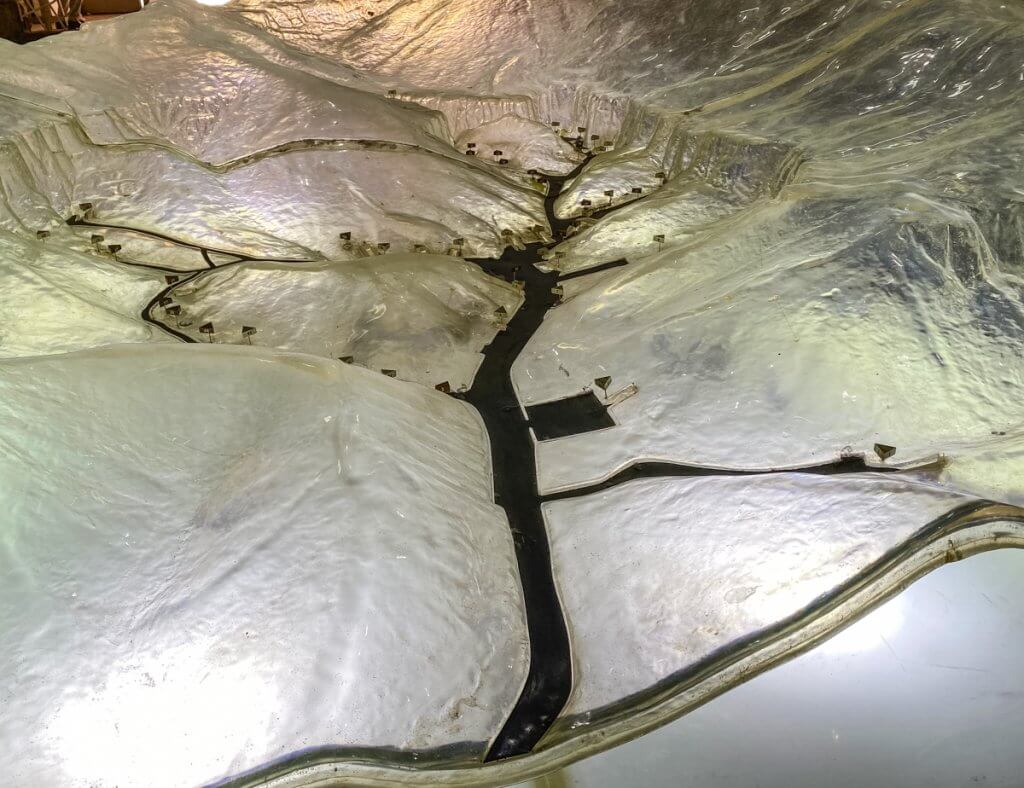
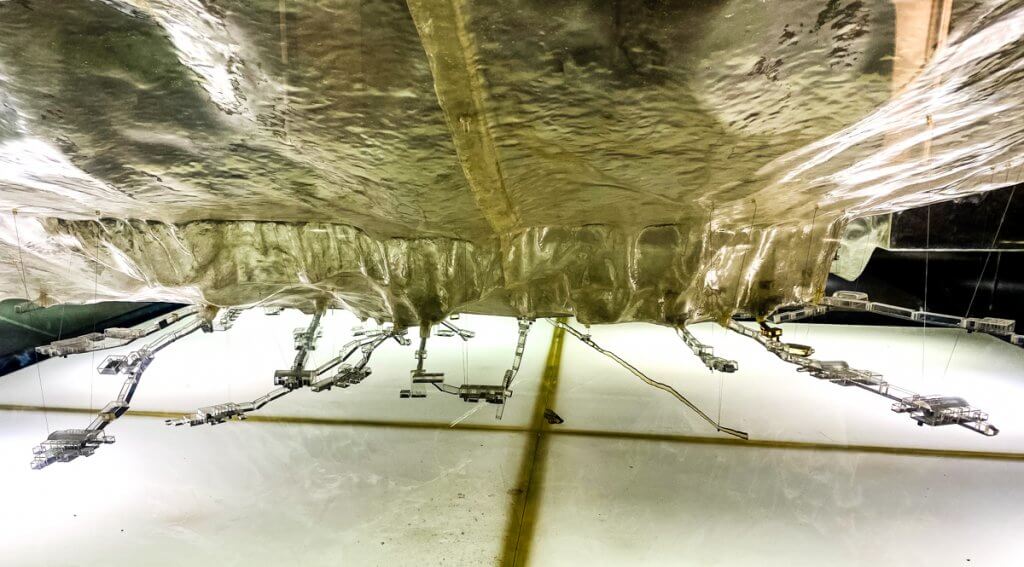
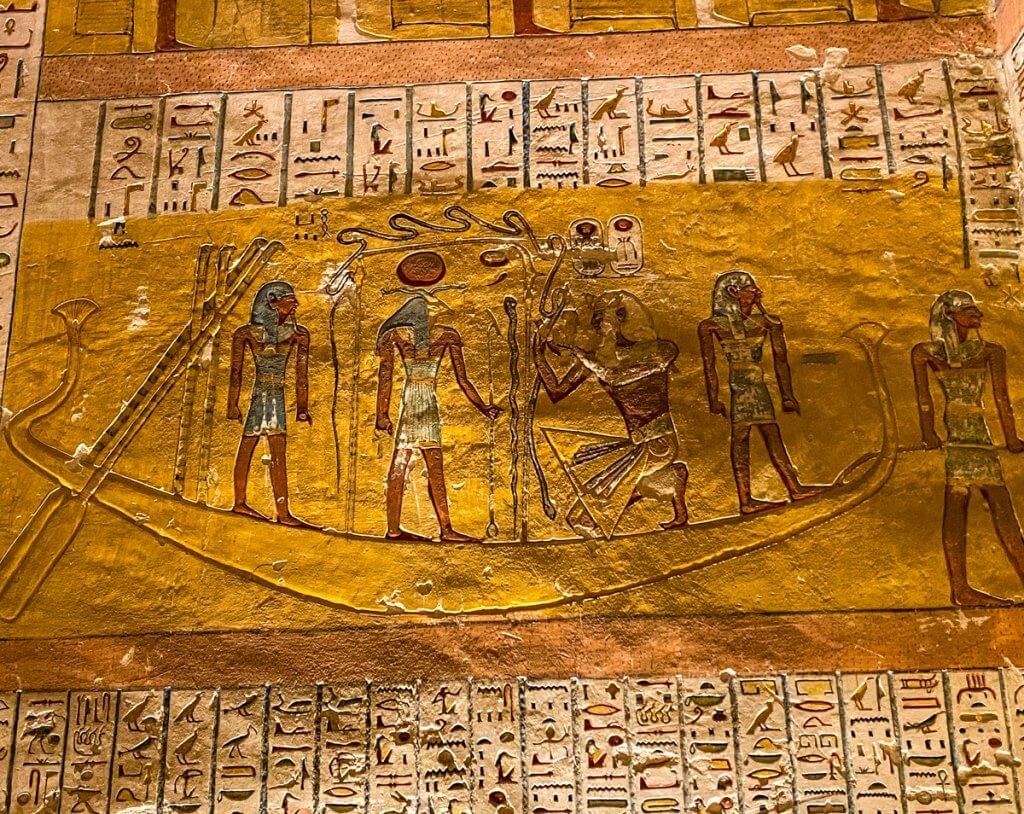
Ramses IV tomb – showing the transition to the afterlife. 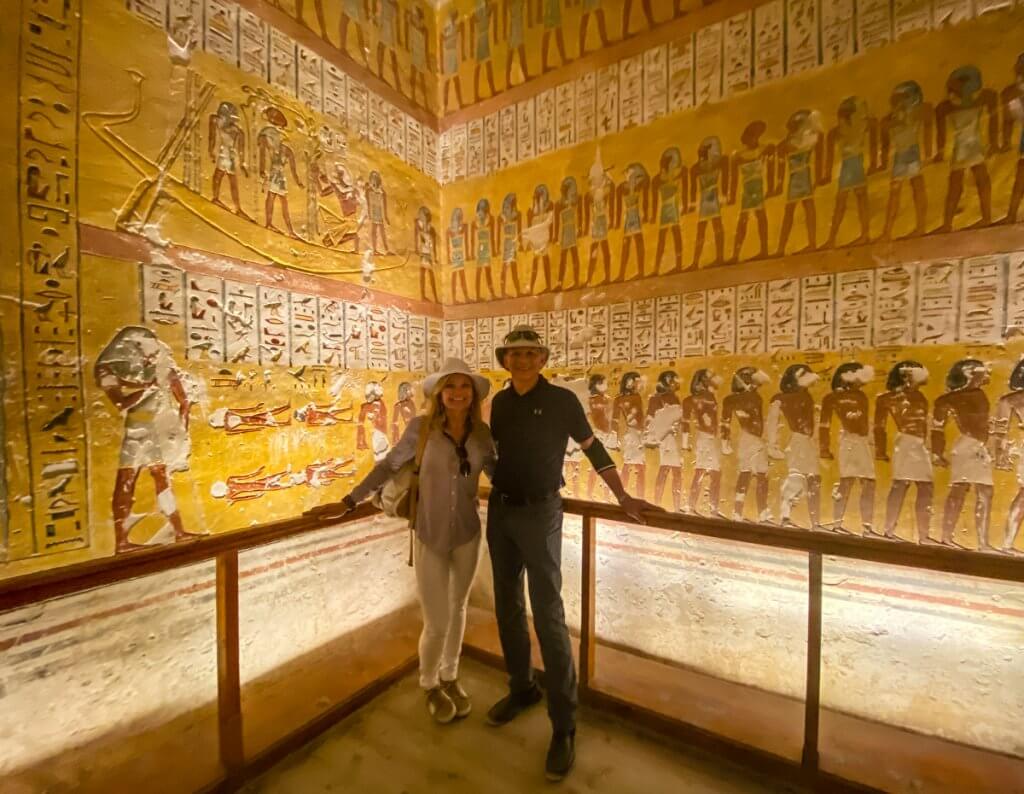
Extensive and well preserved hieroglyphics and relief in the tomb of Ramses IV. 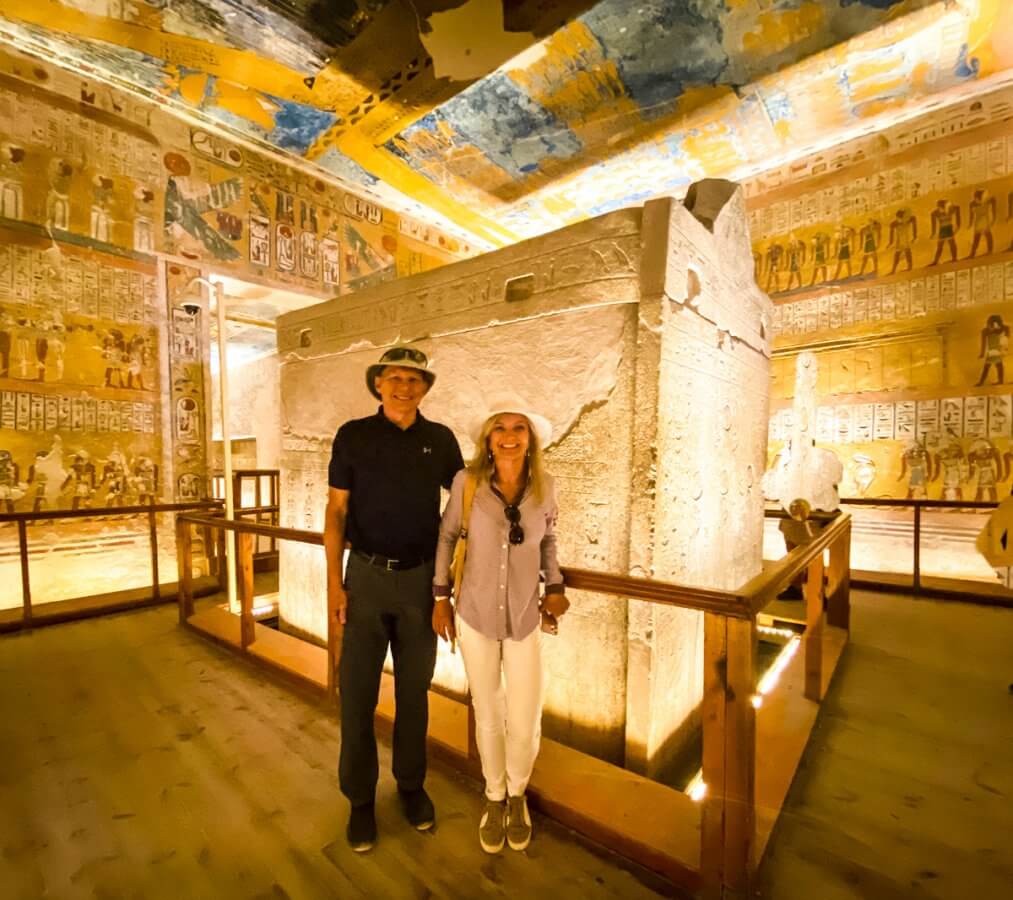
Ramses IV sarcophagus. 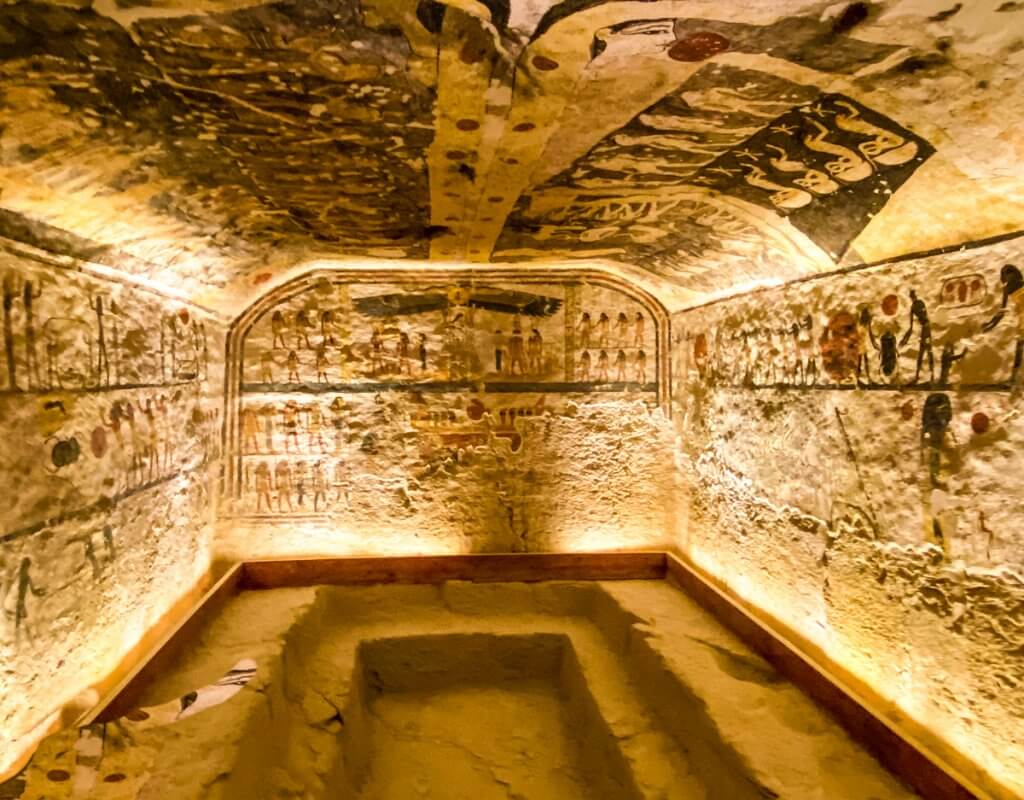
Ramses IV tomb room.
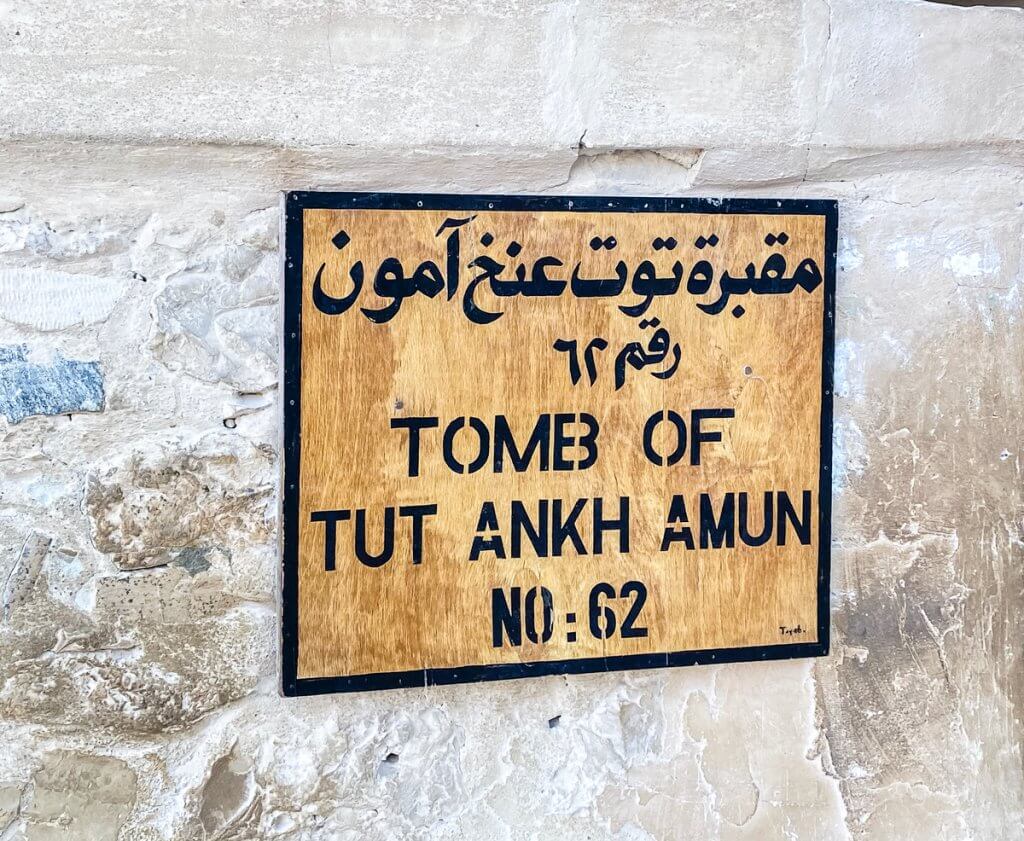
While we went down into several tombs, we only viewed King Tutankhamun’s from the outside. King ‘Tut’, which is so well-known to all of us, was actually quite a minor king for the Egyptians. He only ruled for 9 years, and at a very young age; his reign was fairly innocuous. The reason he is so famous is because of Howard Carter’s 1922 discovery of his completely intact and undisturbed tomb complete with all of its treasures. Until its discovery, tomb raiders had stolen or destroyed the treasures, papyrus records, mummies and … well, most everything … from other discovered tombs in the hundreds, and thousands, of years prior.
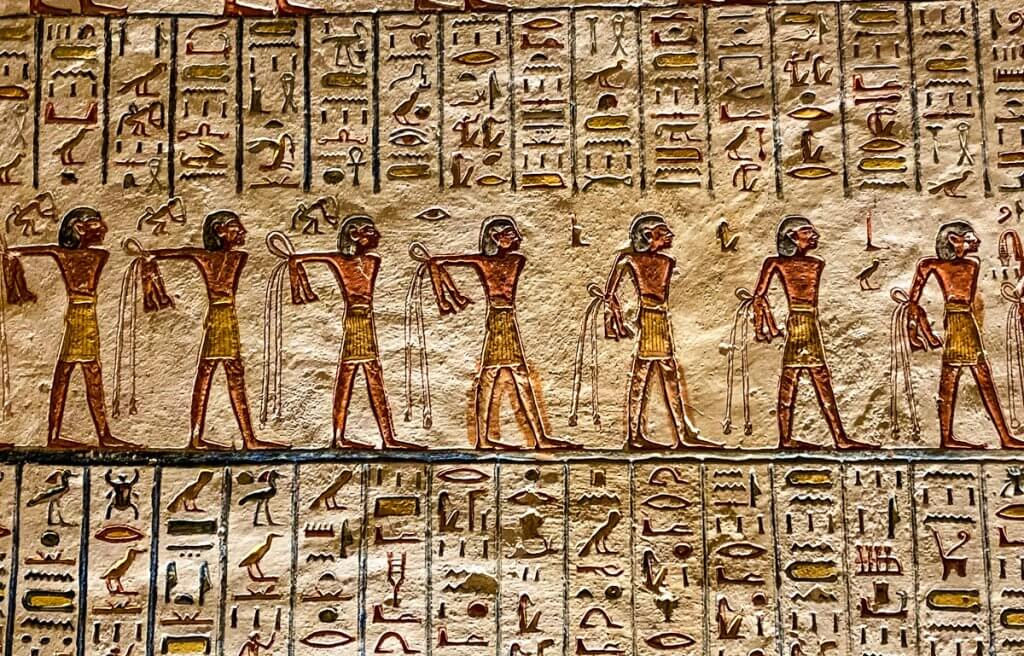
Relief showing slaves in passageway of the tomb of Ramses Vi. Notice that their elbows are tied behind their backs. 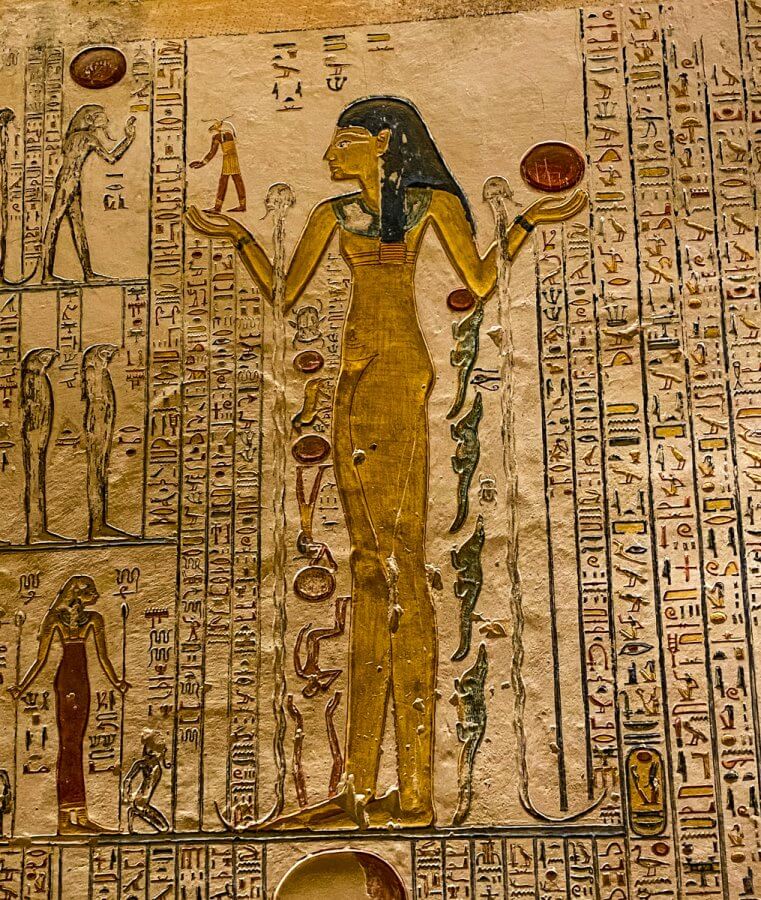
Isis, Goddess of life and magic in passageway of the tomb of Ramses VI. Wiki terms her “one of the goodest goddesses of ancient Egypt”. 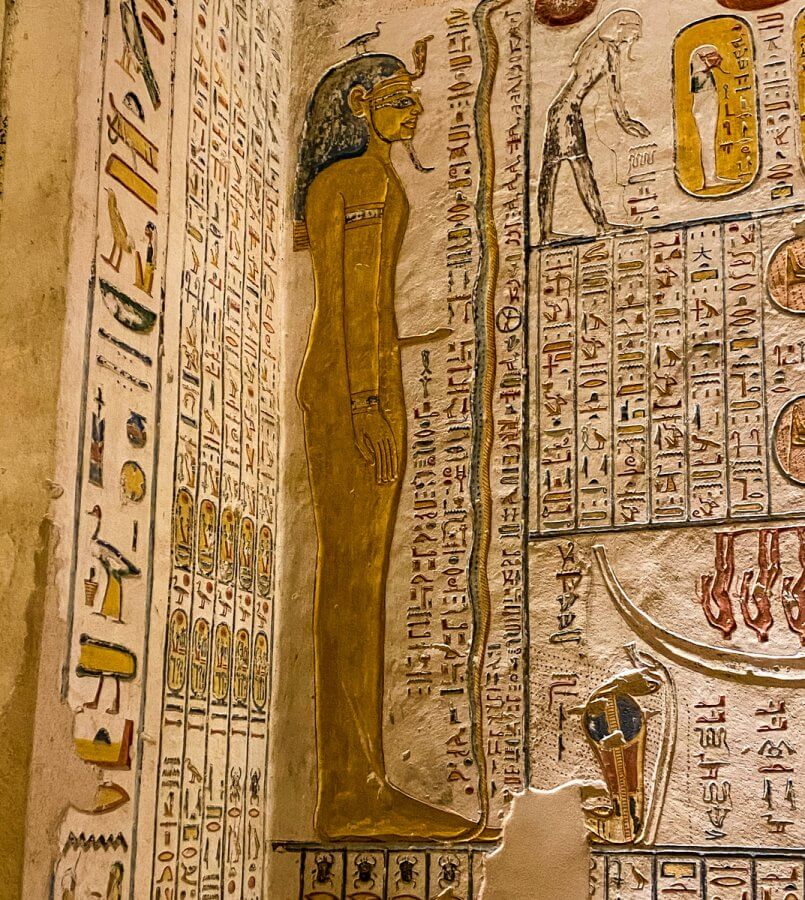
Osiris, God of Fertility, Agriculture and Afterlife. 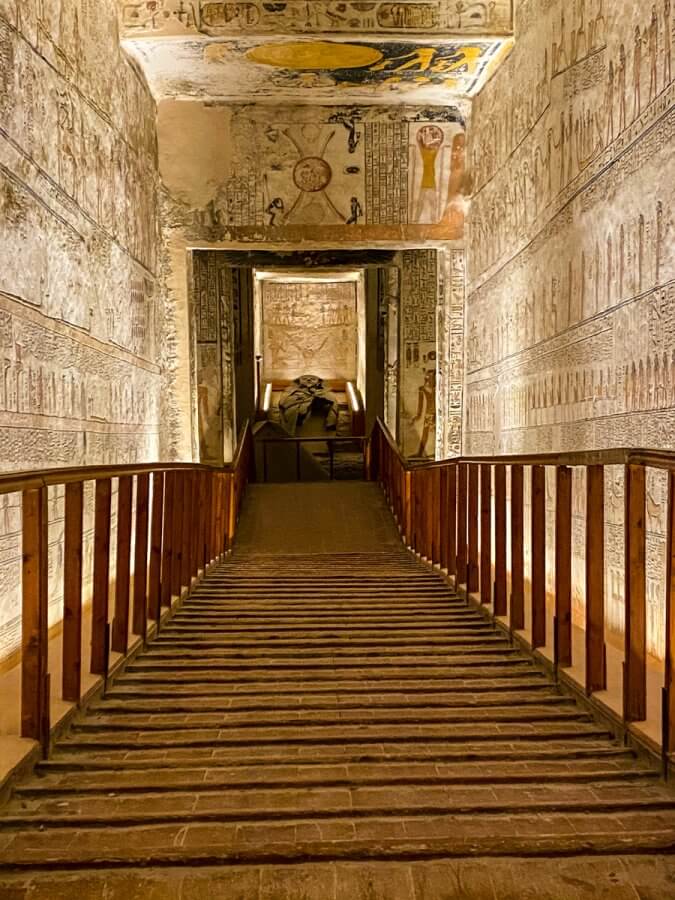
The passageway leading to the tomb of Ramses Vi. The sarcophagus often fit through the passageway by a matter of inches. 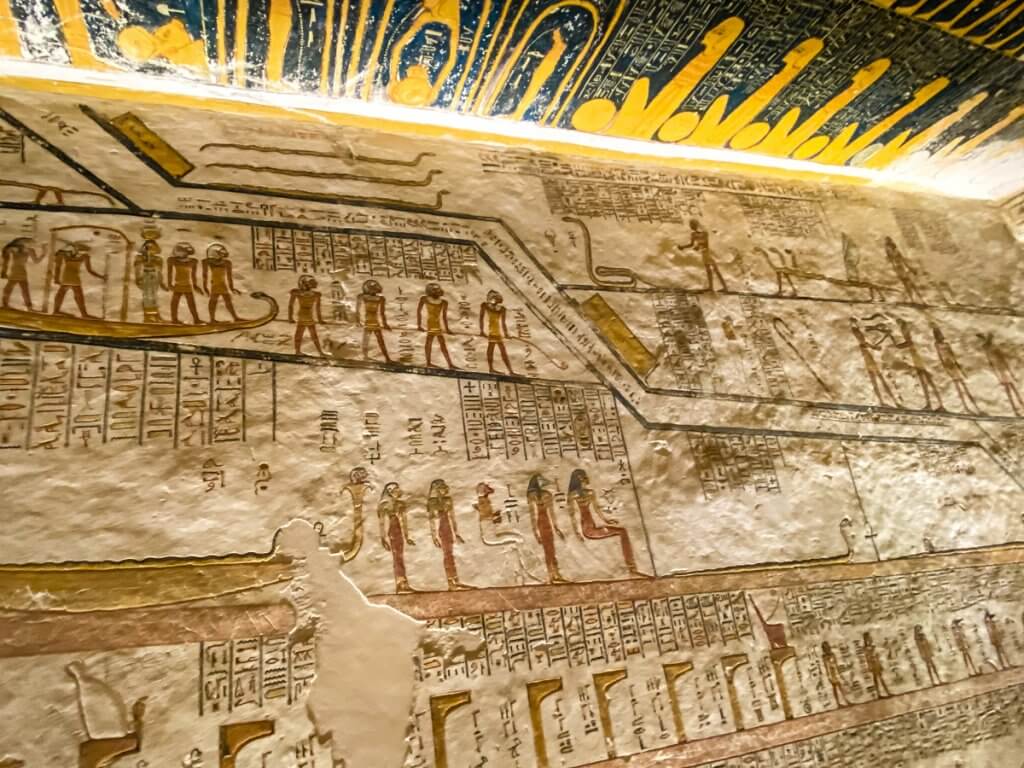
Showing the journey of Ramses IV into the afterlife. 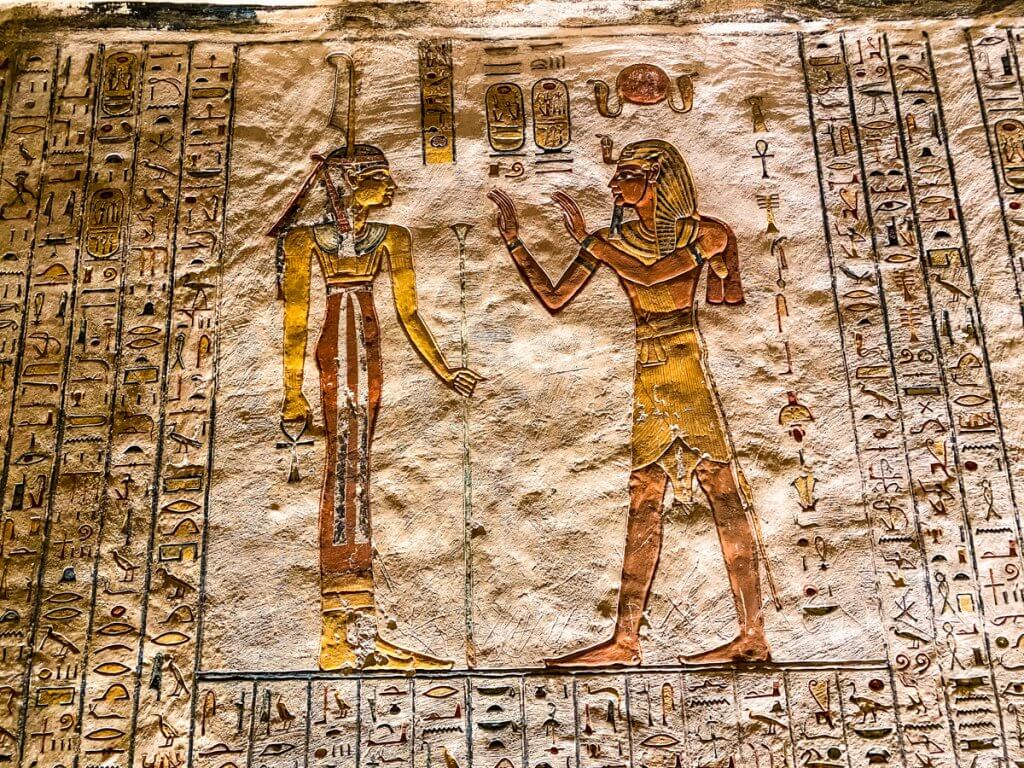
Ramses VI bargaining with one of the gods of the afterlife. 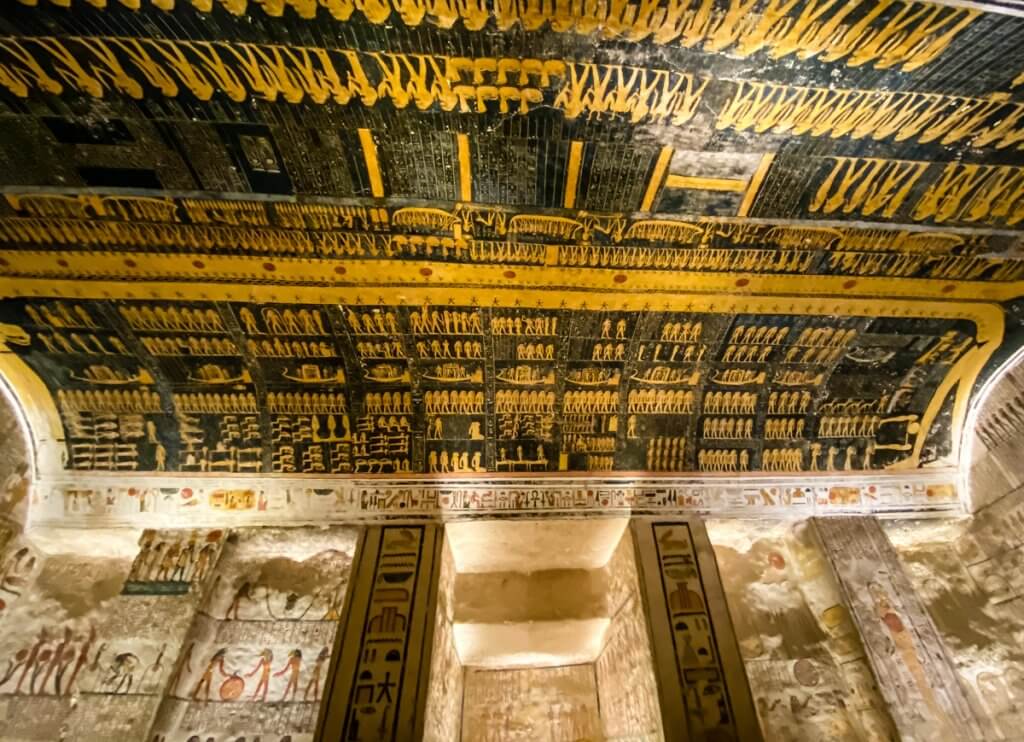
The astronomical ceiling in the passageway of the tomb of Ramses VI. The well-preserved colors were pretty incredible. 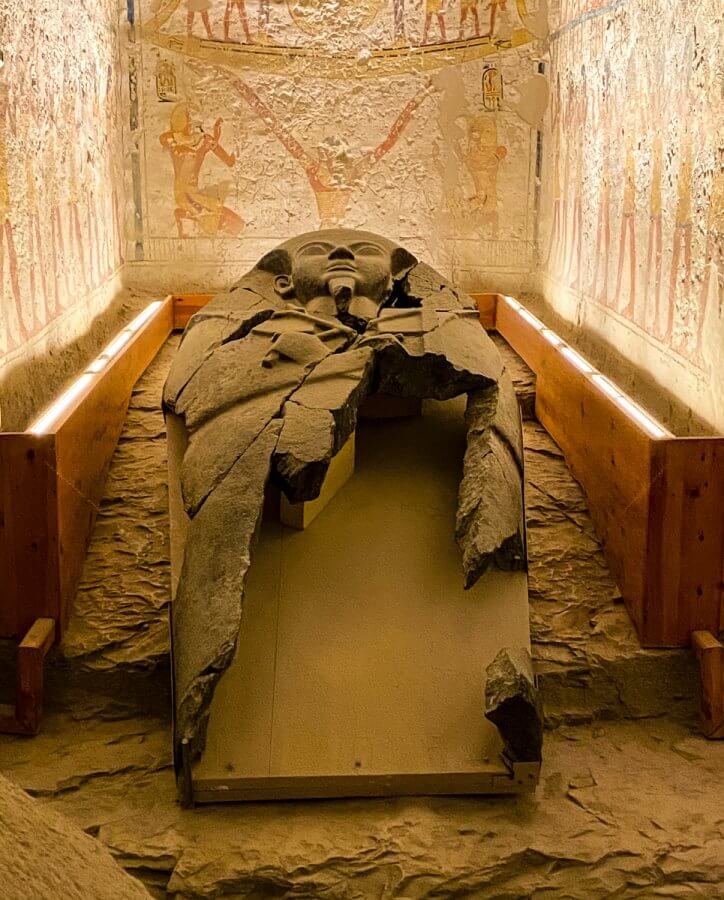
A reproduction of the outer sarcophagus of Ramses VI.
We passed by the famed Colossi of Memnon, known in Ancient Greek times for their haunting voices at dawn. After this amazing but exhausting first day of tours, we wouldn’t be coming back to listen for them the next morning.
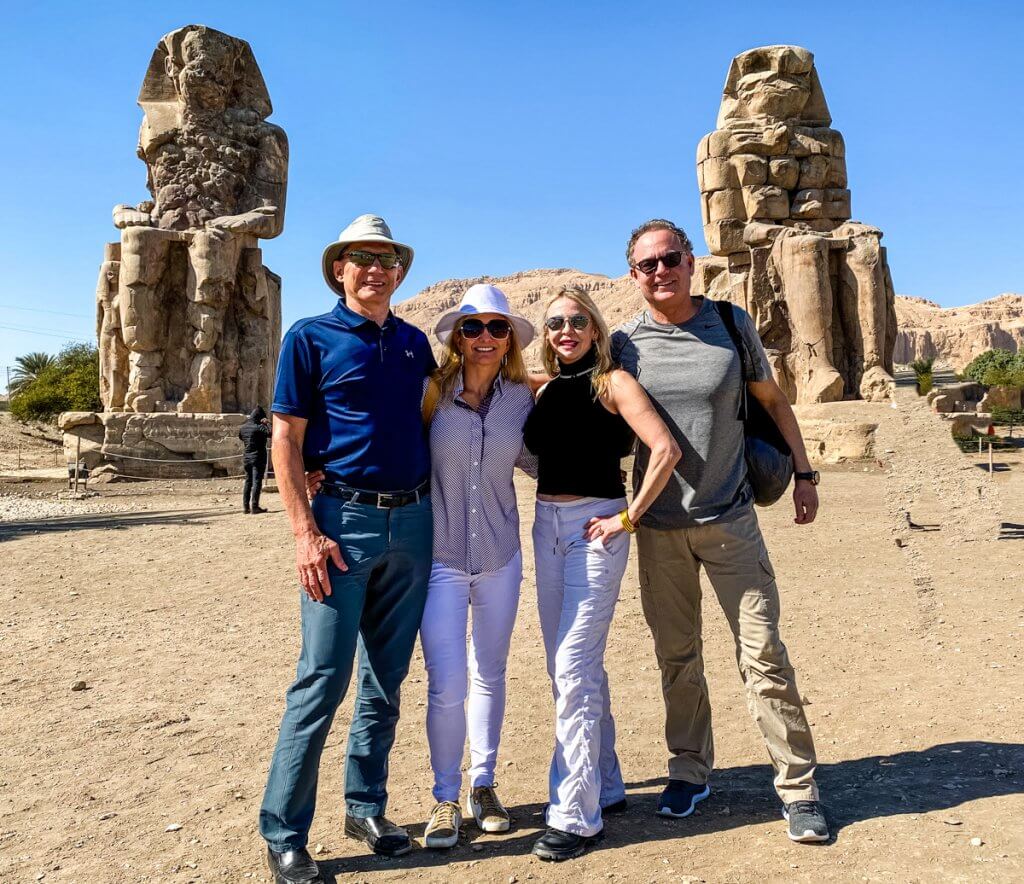
The Colossi of Memnon guarding the Valley of the Queens. Both of these massive stone statues are of Pharaoh Amenhotep III.
We were also able to visit the Valley of the Queens and the Temple of Queen Hatshepsut (hat-ship-suit). Queen Hatshepsut was the 5th pharaoh of the 18th dynasty of Egypt, and considered by many one of the most successful pharaohs. She was the 2nd historically-confirmed female pharaoh, coming to throne in 1478 BC in the stead of her nephew, the son of her deceased half-brother/husband (yes, both, in that order… who thought Game of Thrones was original?!) She ruled until she deemed her nephew, Tutmose III, warrior-ready at age 24, at which time she ceded the throne to him.
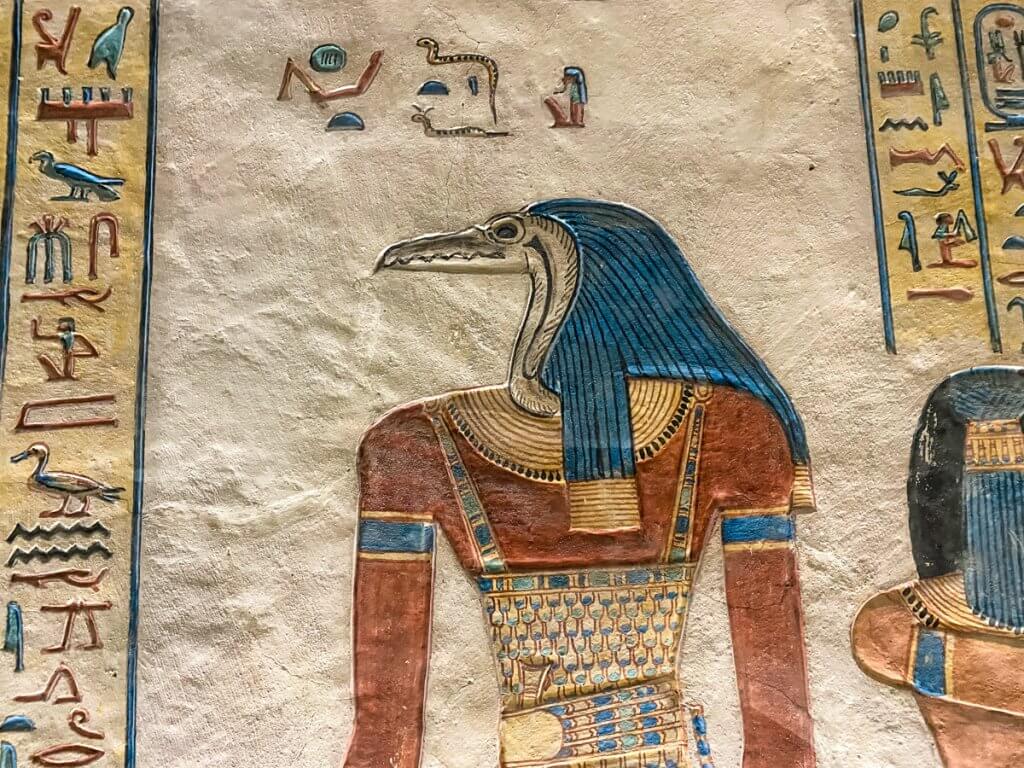
From the tunnel walls of Queen Titi’s (12th century BC) tomb. 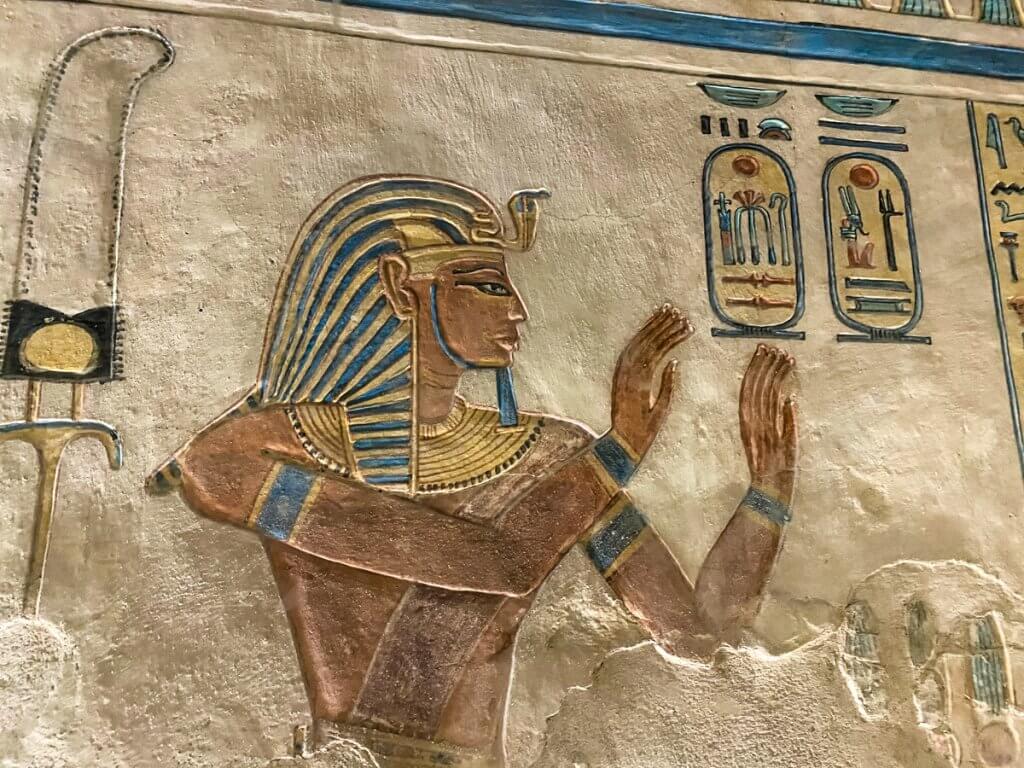
From the tunnel walls of Queen Titi’s (12th century BC) tomb. 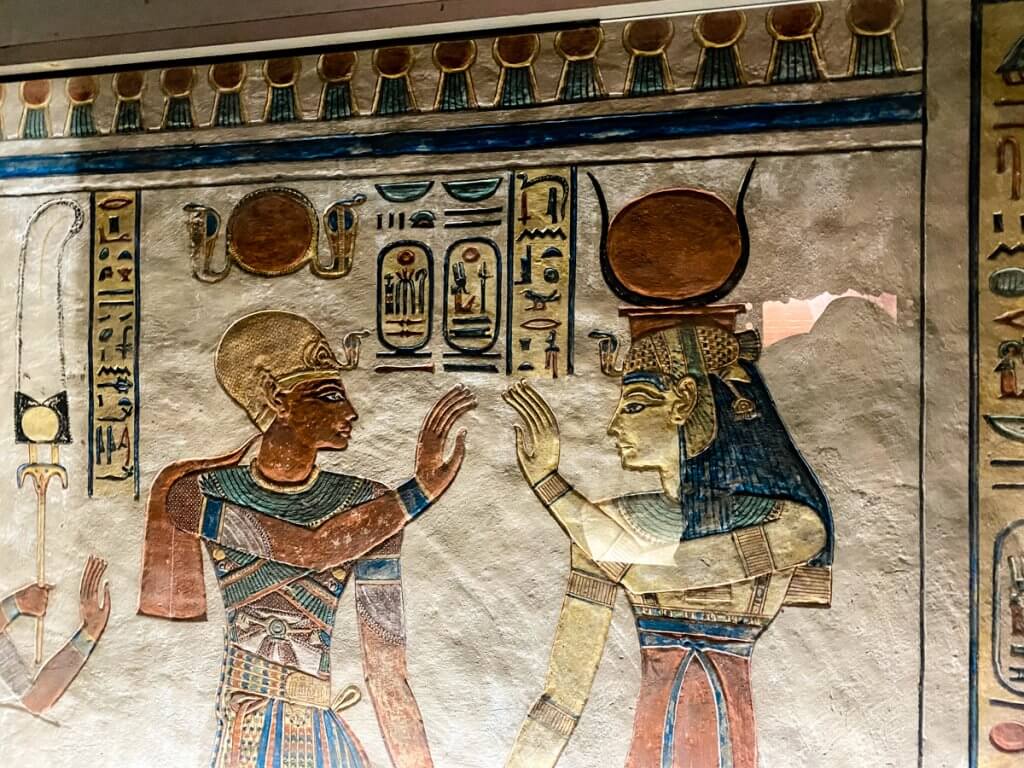
From the tunnel walls of Queen Titi’s (12th century BC) tomb. 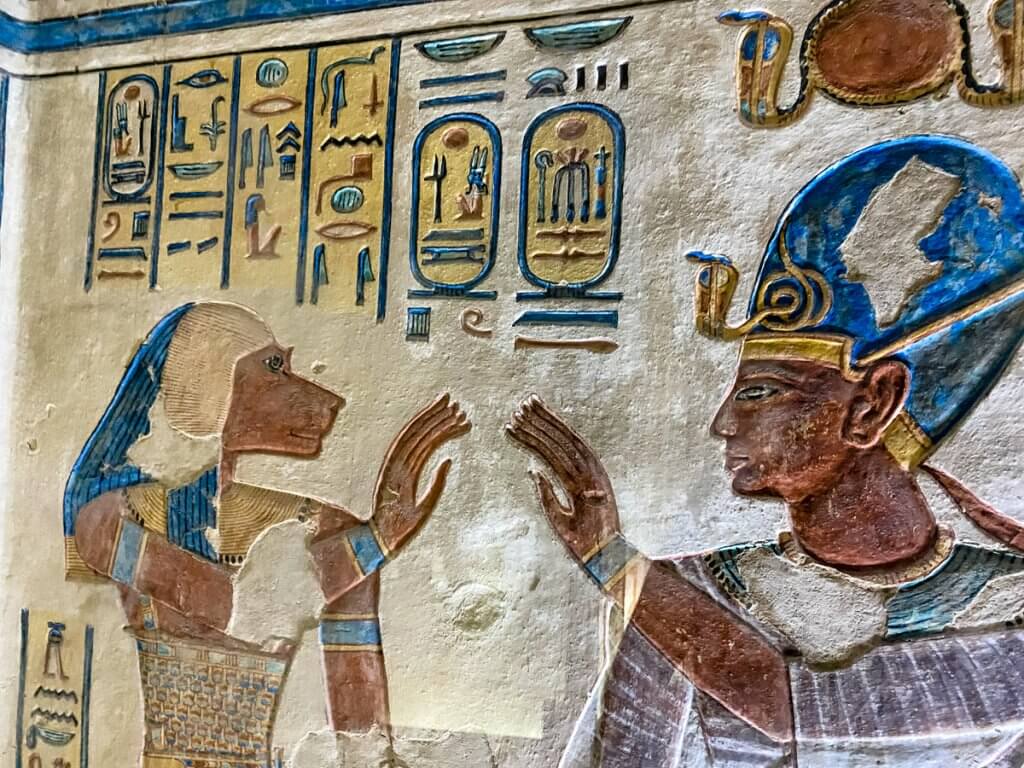
From the tunnel walls of Queen Titi’s (12th century BC) tomb.
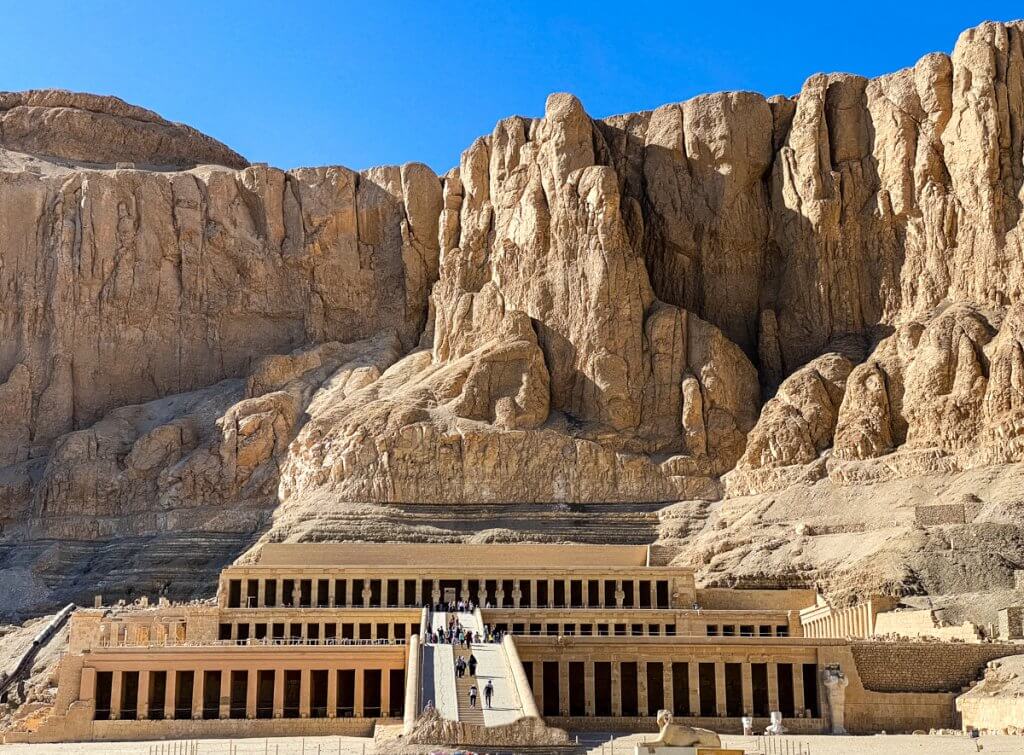
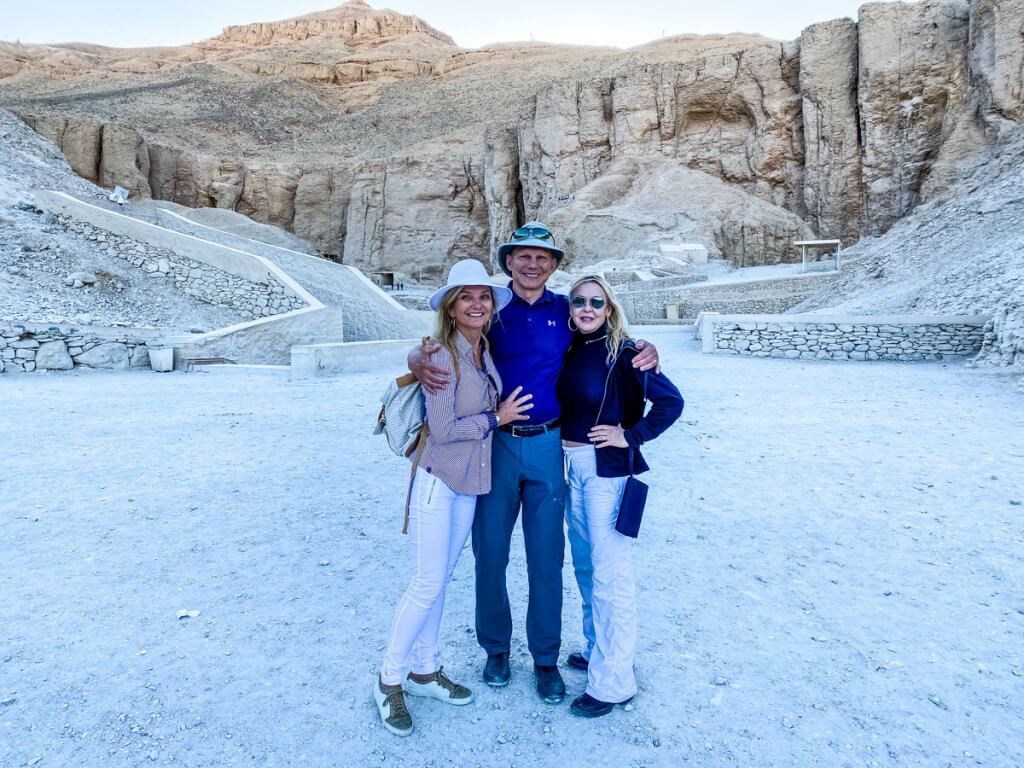
A King and Queens in the Valley of the Kings. We closed the place down.
To celebrate the first night on board the ship, there was a cocktail reception where we had our first taste of Egyptian wine. Lucky for us, we found one we liked!

Captain’s opening night cocktail party.
Day #2 – Karnak Temple and Temple of Khnum
Staying on the East Bank this morning, we began our day with a visit to the Temple of Karnak. Karnak is an extremely vast and large temple complex, with many of the massive pillars – the largest in the world – still in amazing condition (built over 2,000 years ago!). Actually, building on Karnak started in 2,600 BC – 4,600 years ago – and it was continuously built on until 400 BC…. a 3,000 year building project. You can’t help but feel small next to this grand site.
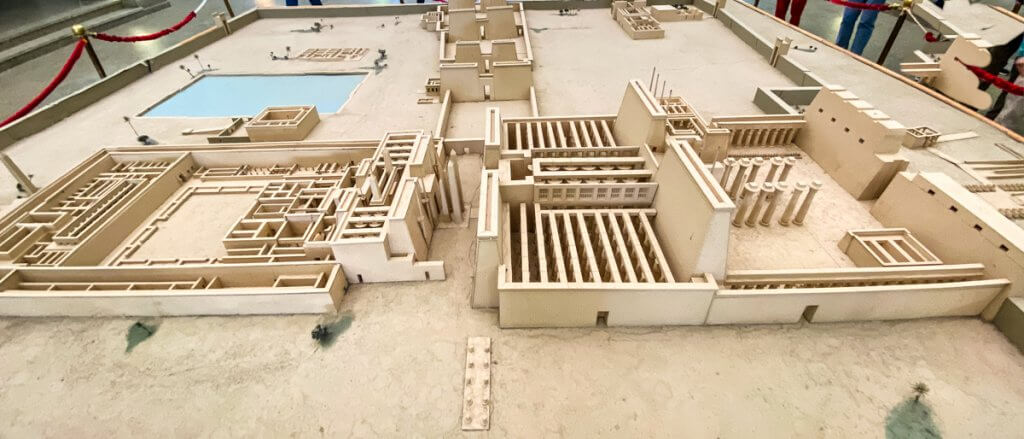
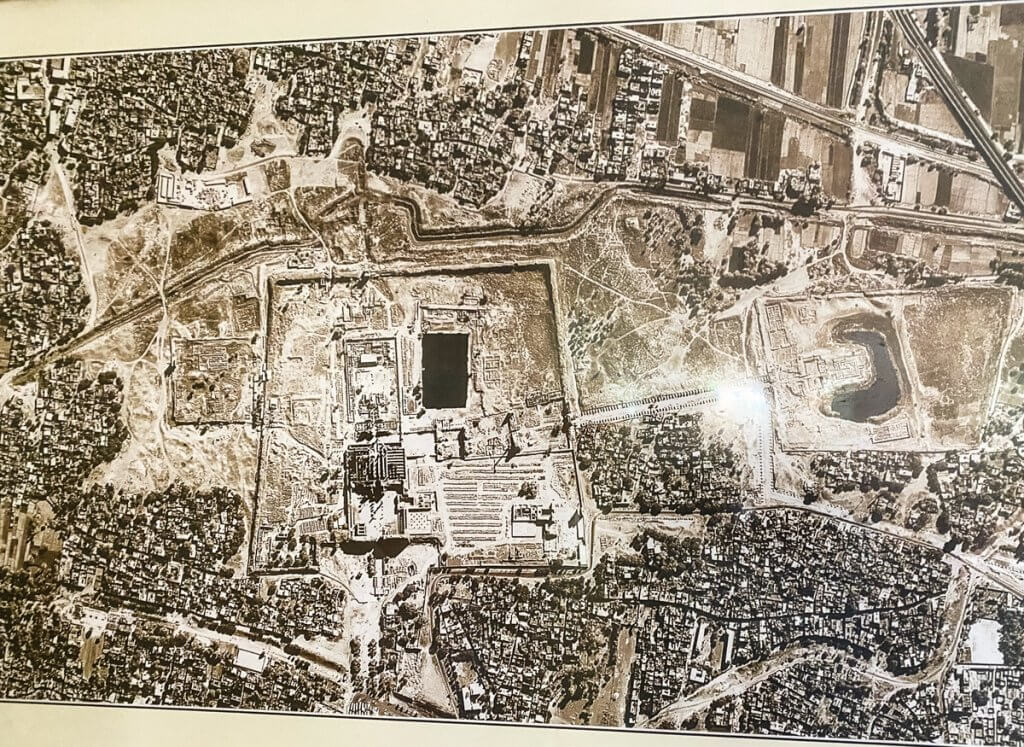
An “older” aerial view of the Karnak temple. 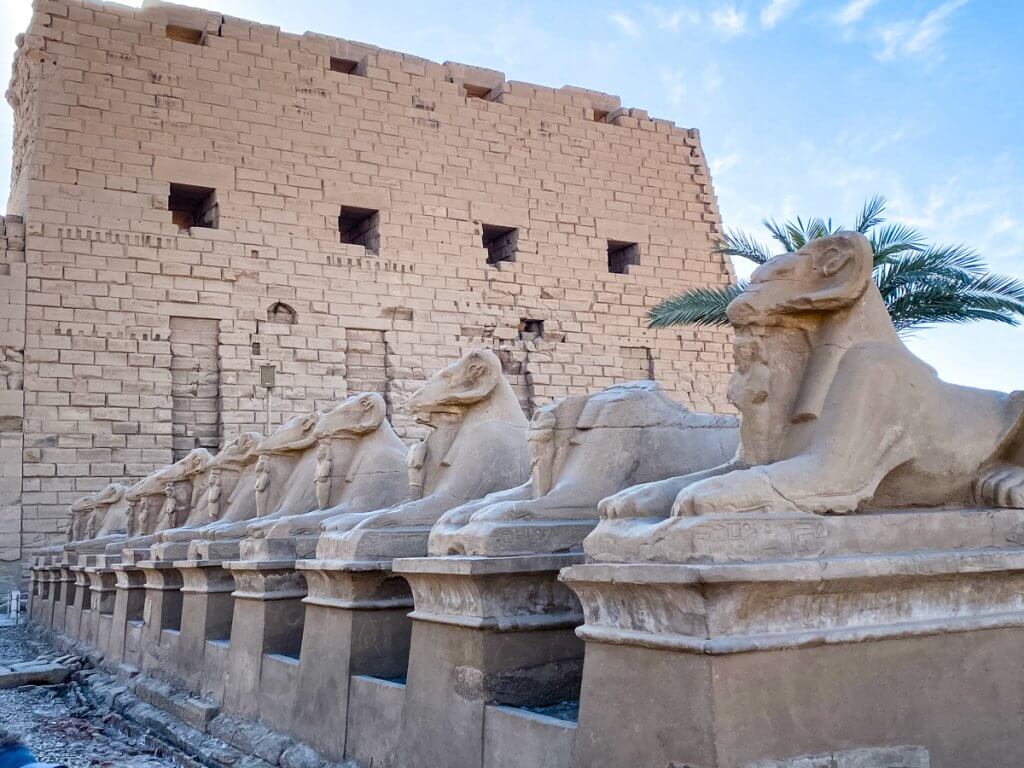
Well preserved ram-headed sphinxes at the entrance of Karnak Temple. 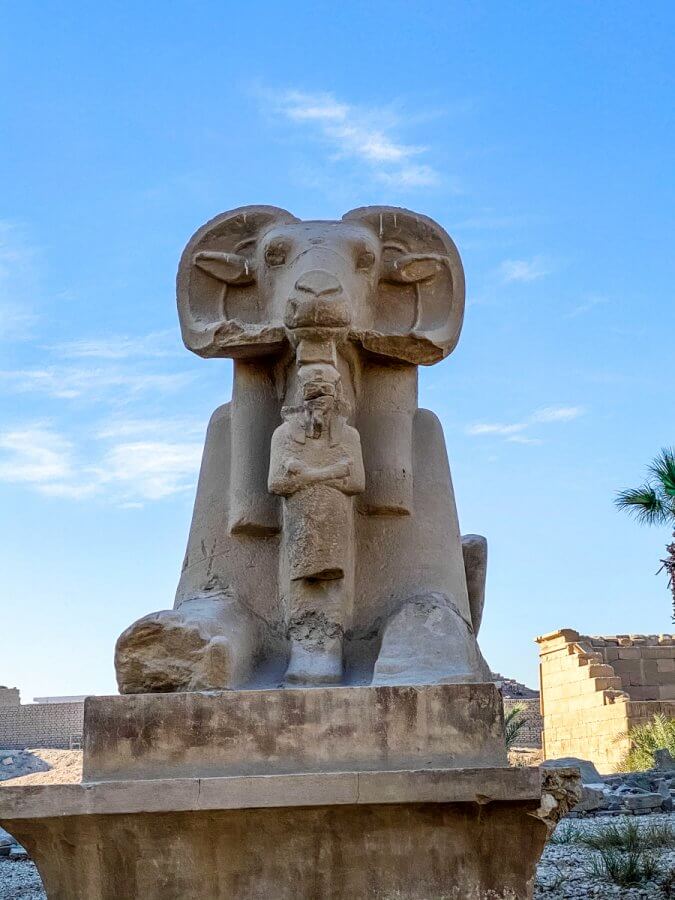
Under the chin of each sphinx, resides a King. 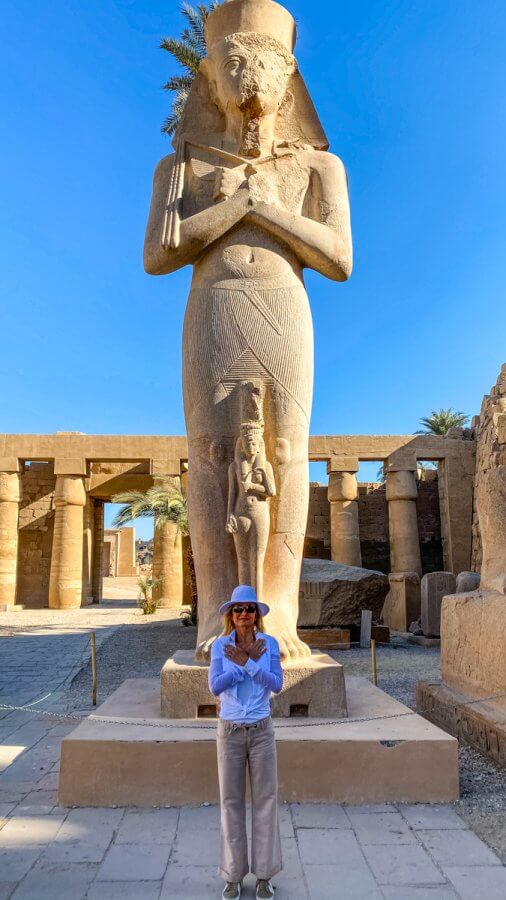
A statue of three queens. 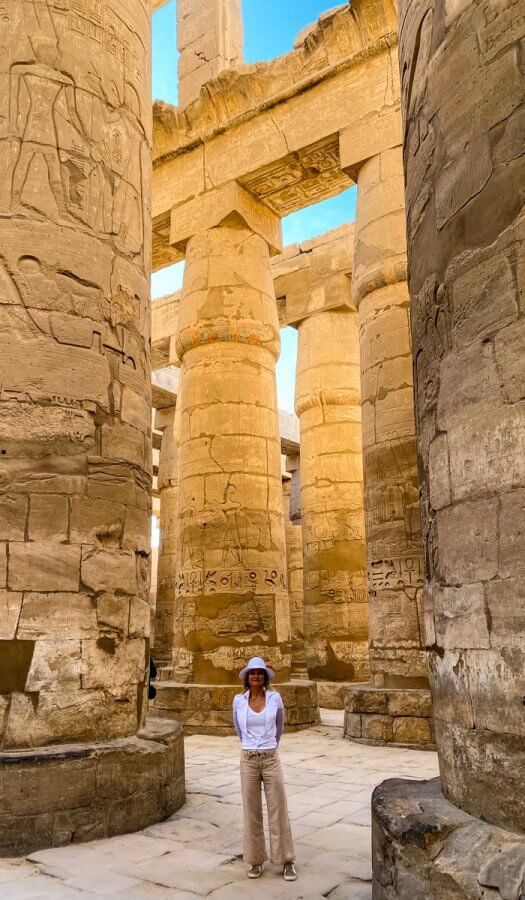
Karnak Temple’s 134 massive columns are arranged in 16 rows. 122 of the columns are 10 meters tall, and the other 12 are 21 meters tall with a diameter of over three meters. 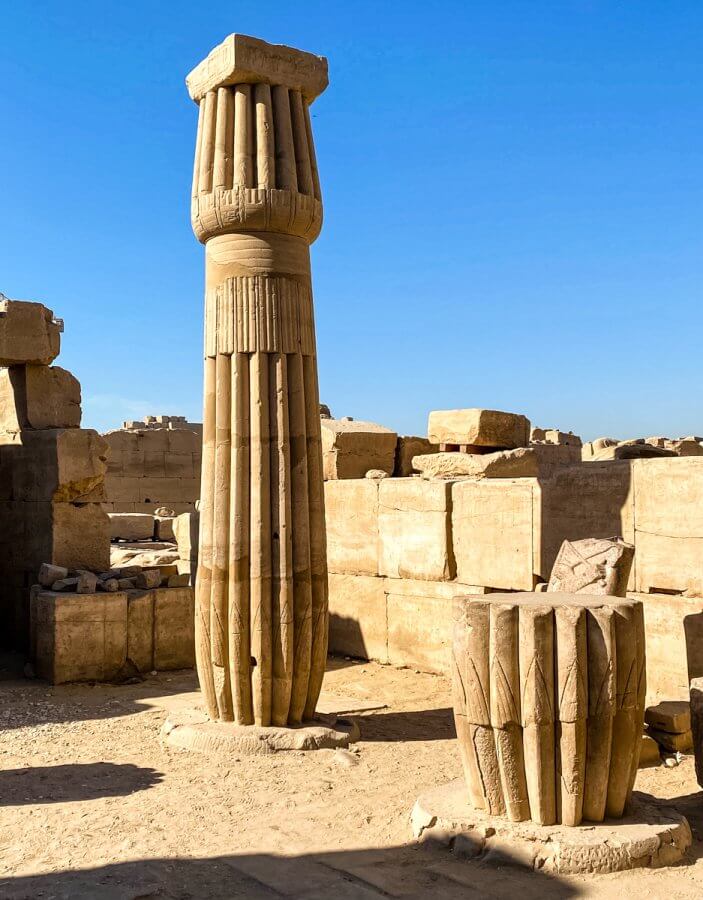
An extremely well preserved example of a column carved in the form of a papyrus. 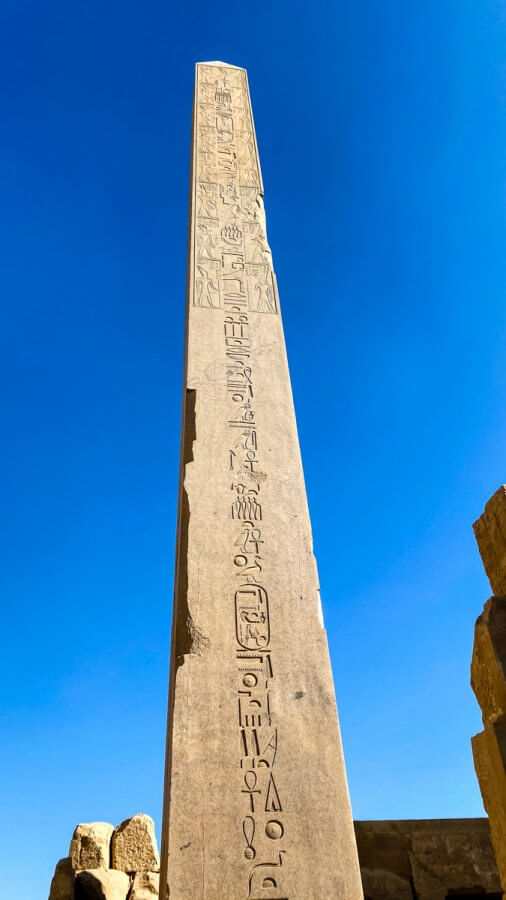
At 102′, the obelisk is one solid block of granite from 125 miles away in the quarries as Aswan. 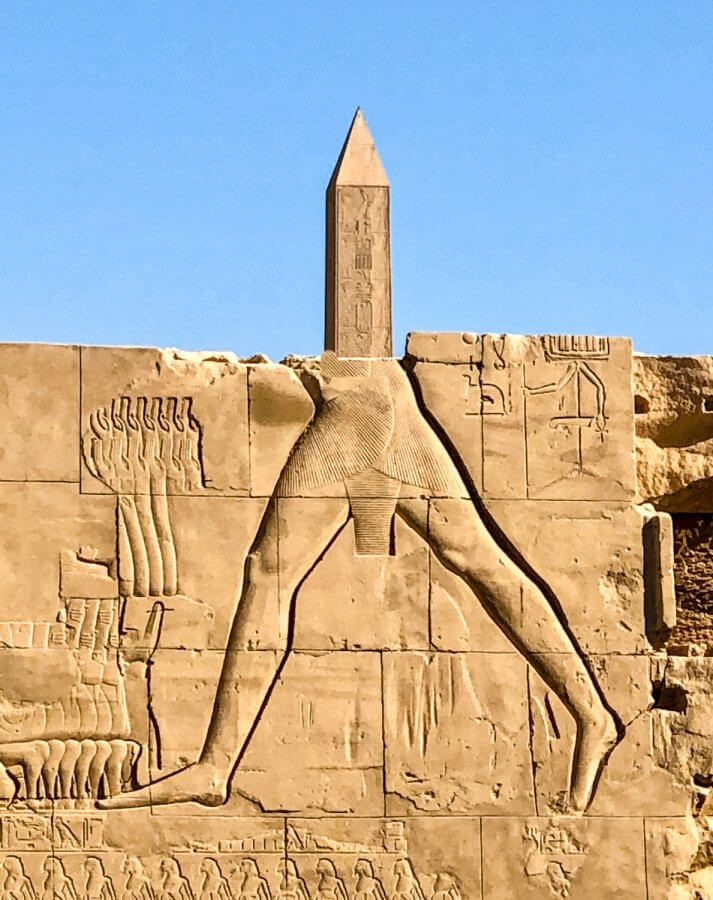
….and an obelisk with legs. 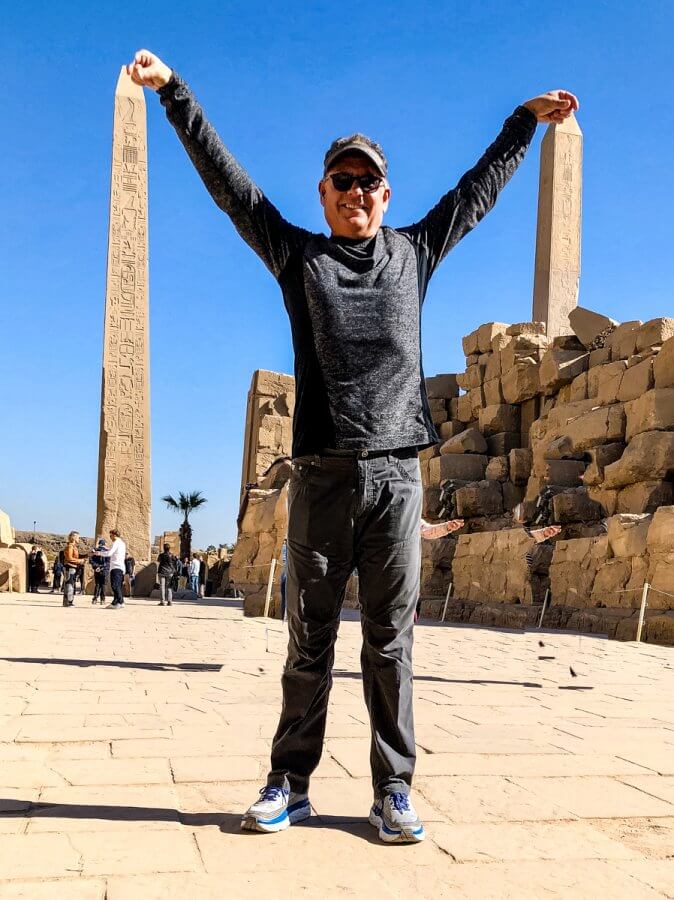
To end our visit to Karnak, Billy shows incredible strength.
Feeling inspired by the Temple of Karnak, we returned to the boat where we set sail for Esna while enjoying lunch on the upper deck.
Upon arriving in Esna, our Egyptologist Ossama guided us around the Greco-Roman Temple of Khnum. The beautifully preserved Great Hypostyle Hall was built during the reign of the Roman Emperor Claudius; it was excavated from the silt that had accumulated through centuries of annual Nile floods and is about 30 feet below present-day street level.
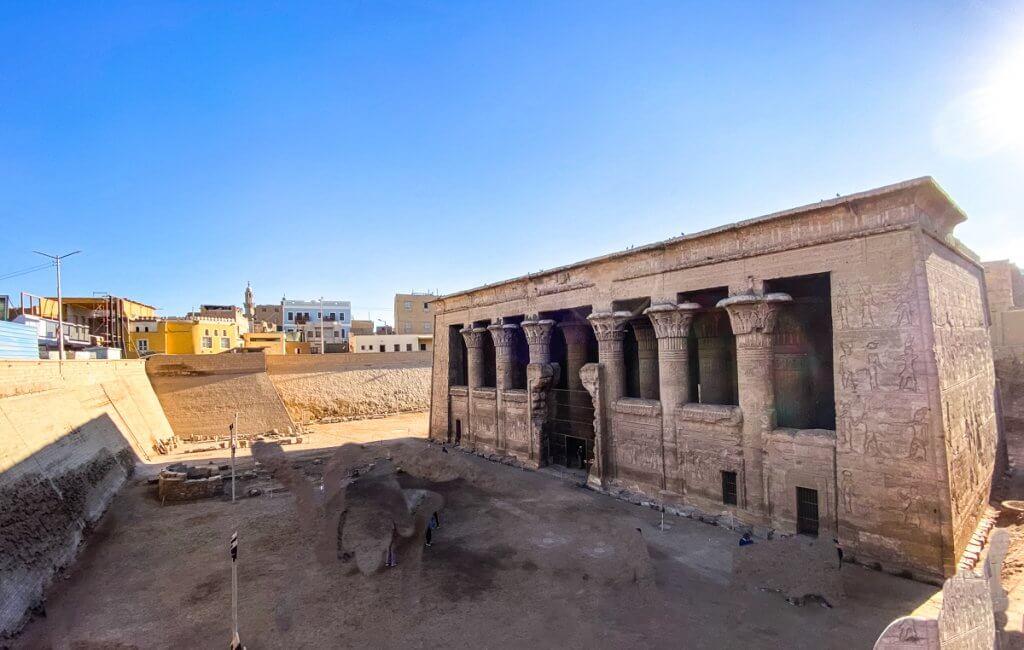
The Temple of Esna is particularly well preserved because it was partially buried for thousands of years. About 2/3 of the temple was underground. 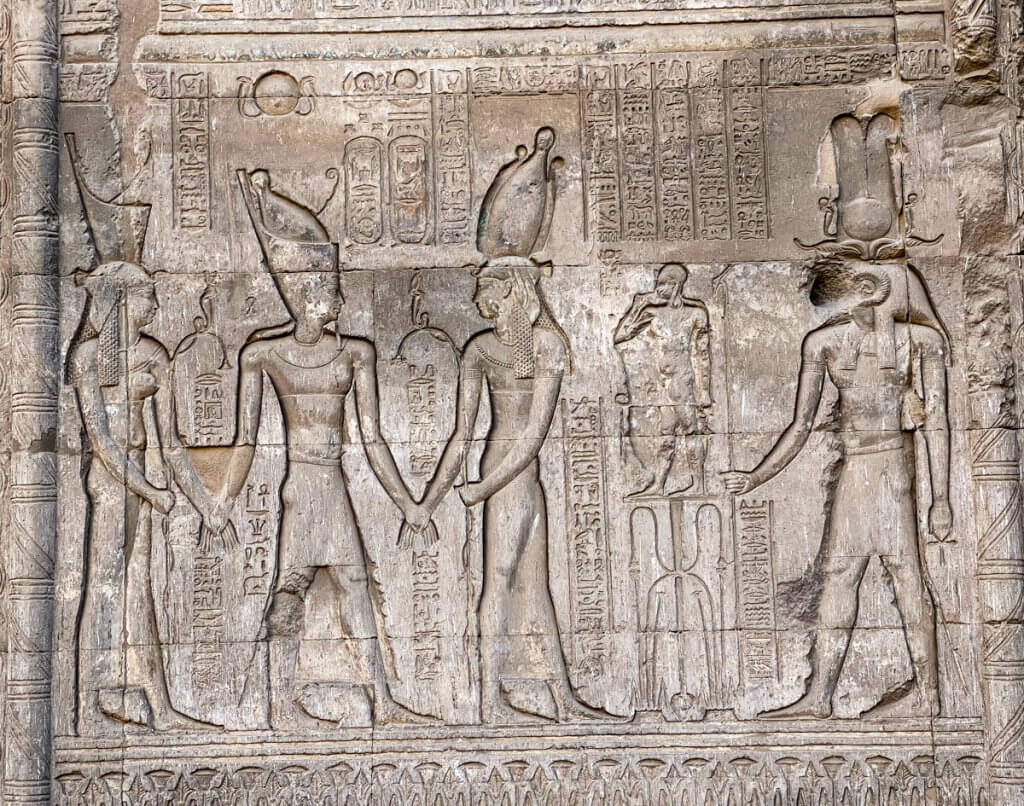
Hieroglyphic symbols explain the deeply carved reliefs. 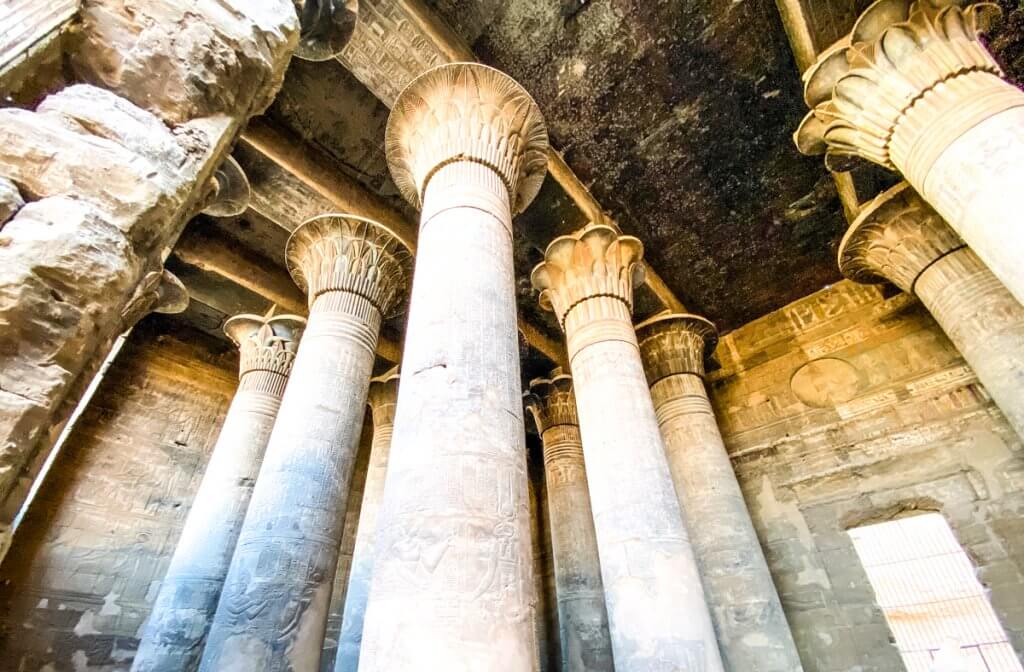
Columns supporting the roof structure at the Temple of Esna. 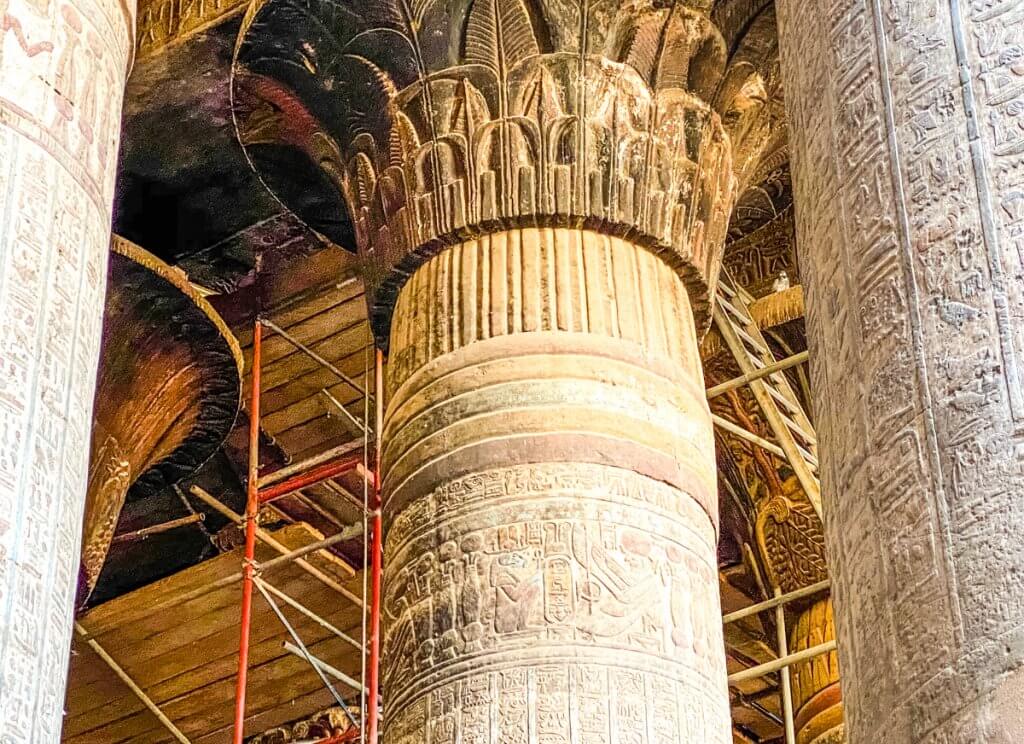
The color on this column is original. 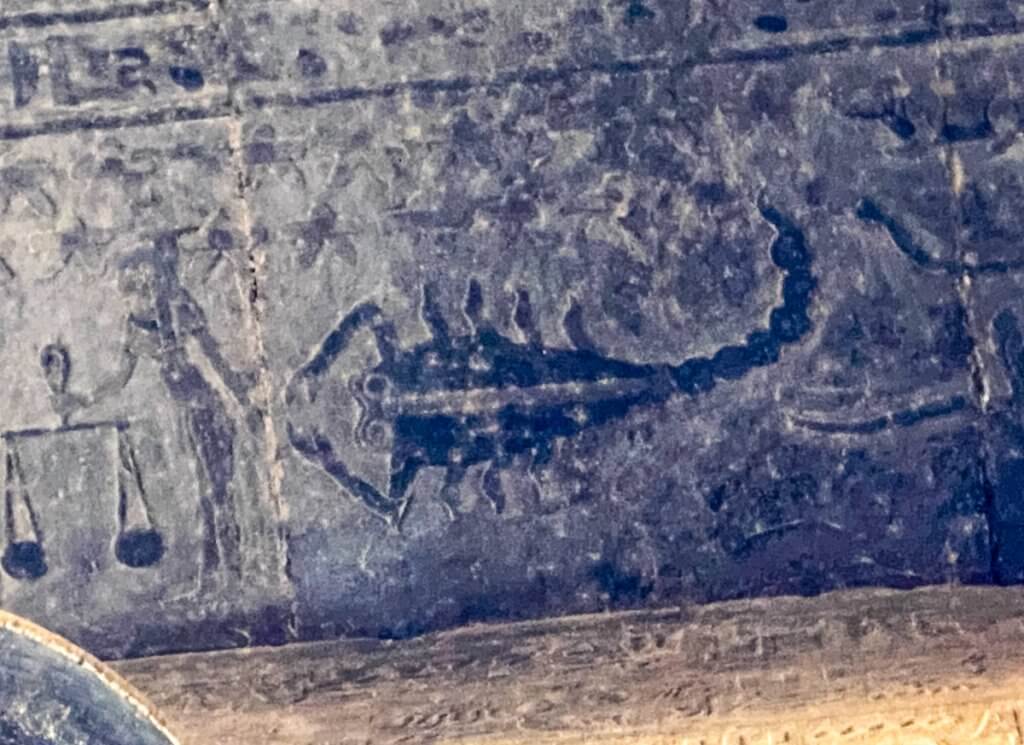
Constellations adorned the ceiling of the Temple of Ensa. 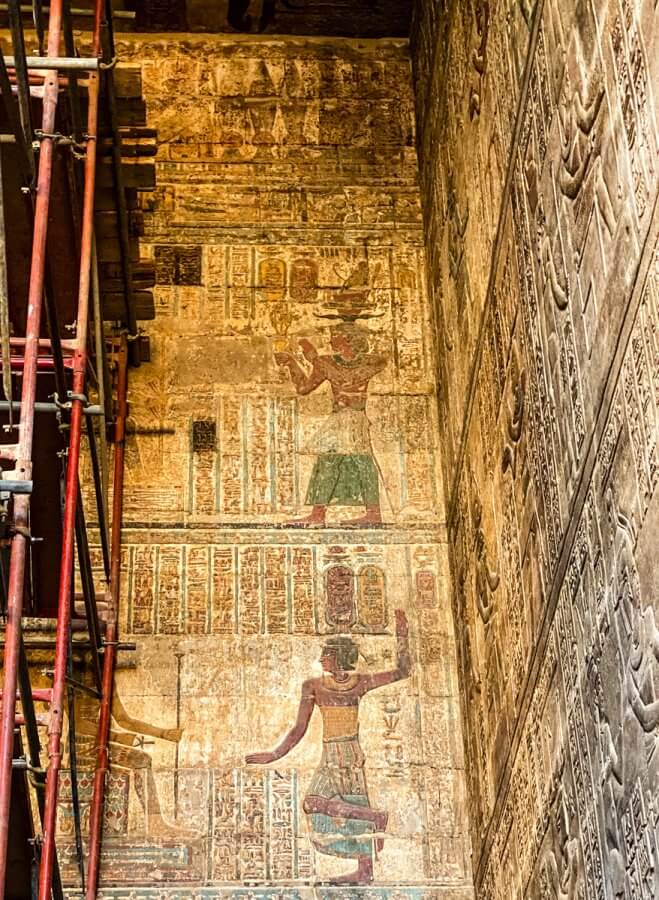
Restorations at the Temple of Ensa brought out all of the colors magnificently.
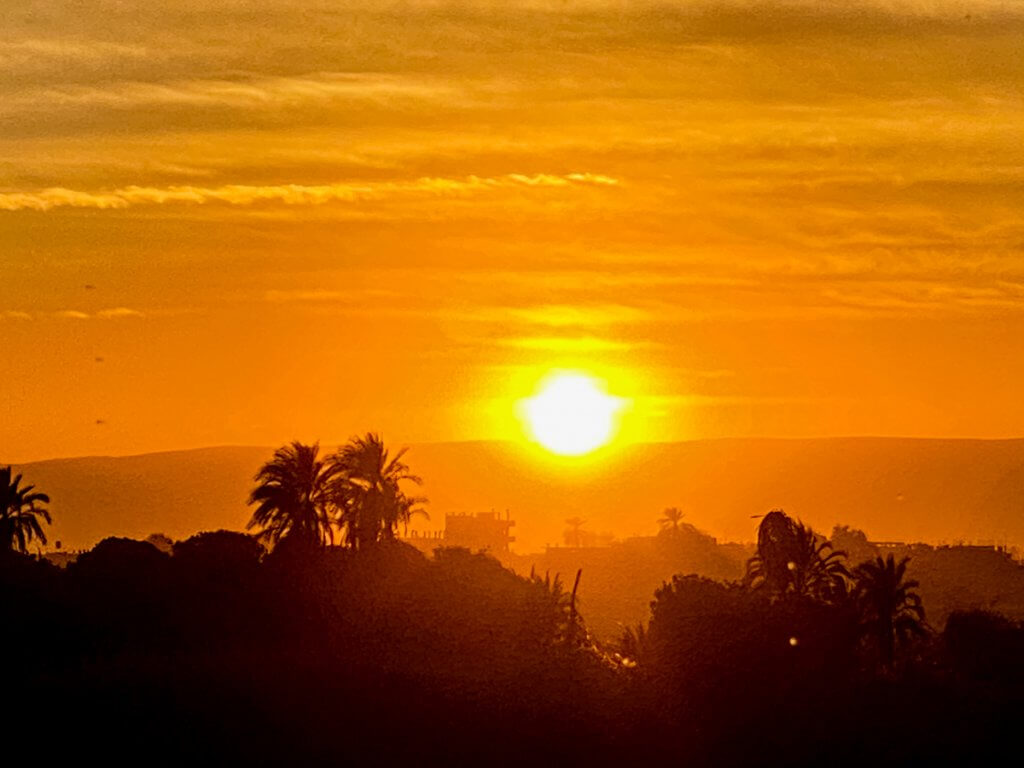
A gorgeous sunset brought our 2nd day to a close.

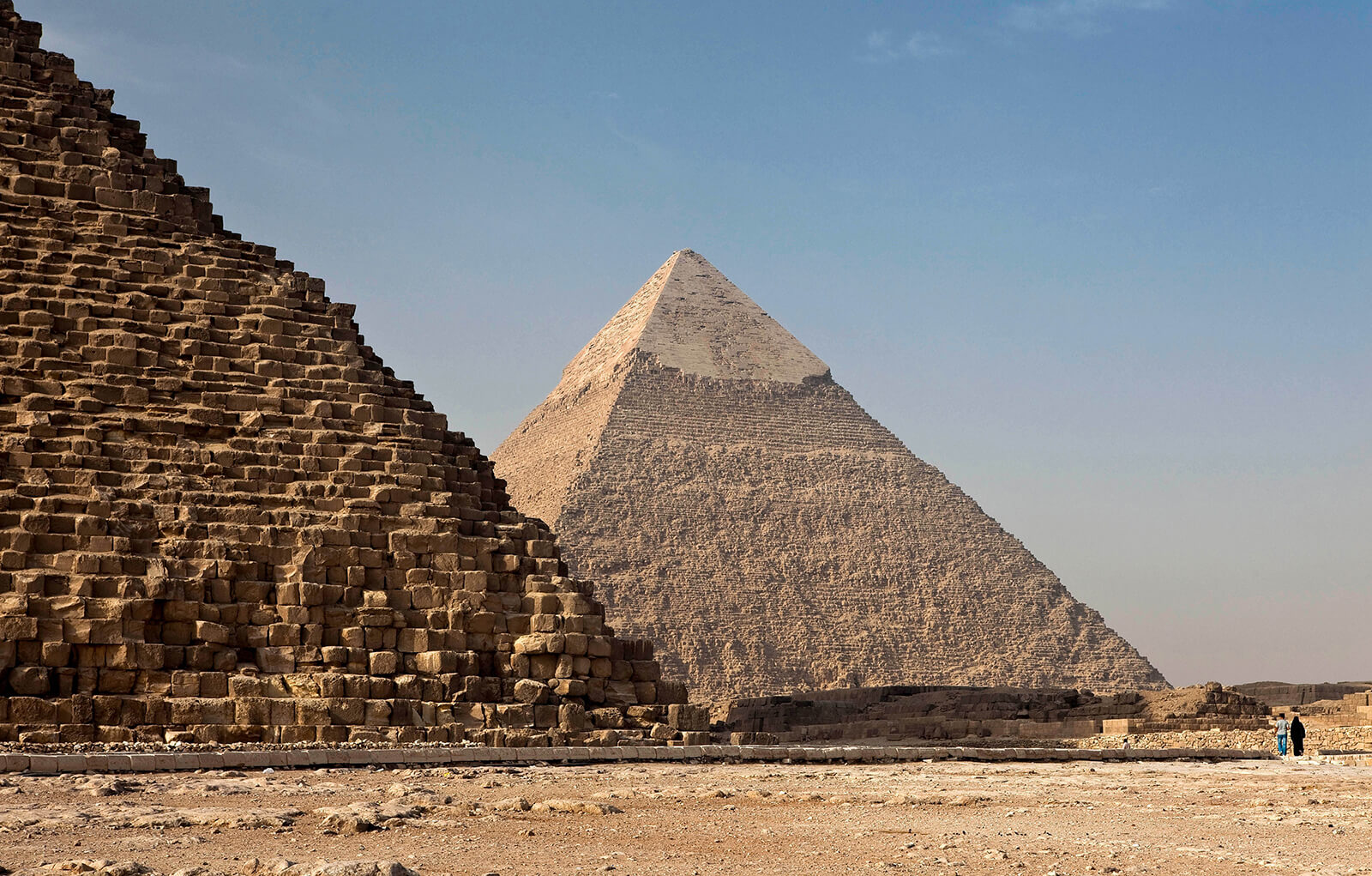


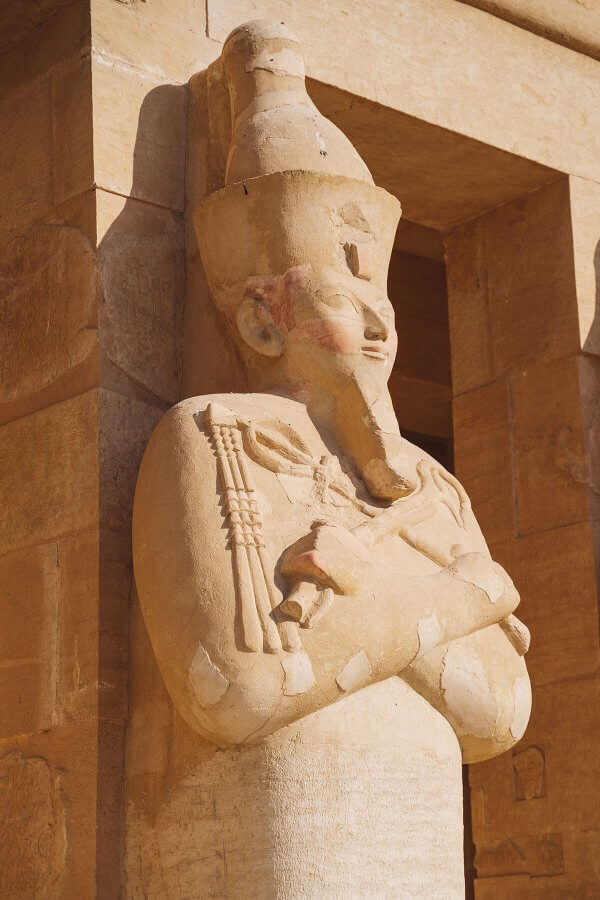
What a fantastic read!! Such fascinating history wonderfully encapsulated. I love this blog and I miss you guys!!
Awww, thanks sweet Will. We could never write like you, but we do love keeping this journal and these memories of our travels. We miss you too!!